Looking for the best money games for kids? I’ve personally reviewed dozens of fun kid money games and financial literacy board games for beginners, and dish on my favorites.
I set out to find the best money games for kids by reaching out to dozens of retailers and asking them to send what they’ve got.

And you know what I found? There are quite a few golden nuggets out there that will teach your kids about money in a fun way – playing money games.
Let’s look at the criteria I used when coming up with this list of educational money games before we dive into it.
Fun Money Board Games – Criteria for Making this Best Money Games for Kids List
Wondering how I chose which money games for kids to include? I’m glad you asked!
Well, first off, I had to physically play with the money game. I mean, how else would I know if it was any good or not? You can only glean so much information off of a website.
While playing with these games, I specifically was looking for the following things:
- Fun Factor: My brand, Money Prodigy, is ALL ABOUT putting fun + money education in the same sentence. So, this was a huge factor for me. Was the game actually something a child would have fun playing with or without their family?
- Educational Factor: Is there at least one money lesson to be had from playing the game, or is the game merely a fake storefront for money education?
- Ability to Learn Solid Money Lessons (without Total Overwhelm): I wanted there to be several core money lessons without overwhelming someone. I mean, I’m of the impression that it’s better to master 1-2 money skills at a time, and then move on to others. So, the best money games for kids were ones where you could focus on a small number of money skills at a time. And then another round of the game? You might pick up on something else.
And let me tell you, not every game I reviewed made the cut into this blog post.
Pssst: Do you have a money game for kids and would like me to test it out for possible inclusion in this post? Get in touch through my contact form.
FYI: these are in no particular order, but I have categorized them roughly by the money lessons they focus on.
Category #1: Coin Counting Games for Kids + Money Math Games
Included here are money games geared towards teaching kids how to count, and how to complete money math problems.
Best Money Games for Kids #1: Money Bags – A Crazy Coin Counting Game
Suggested Age Range: 7+ years
Players: 2-4 players
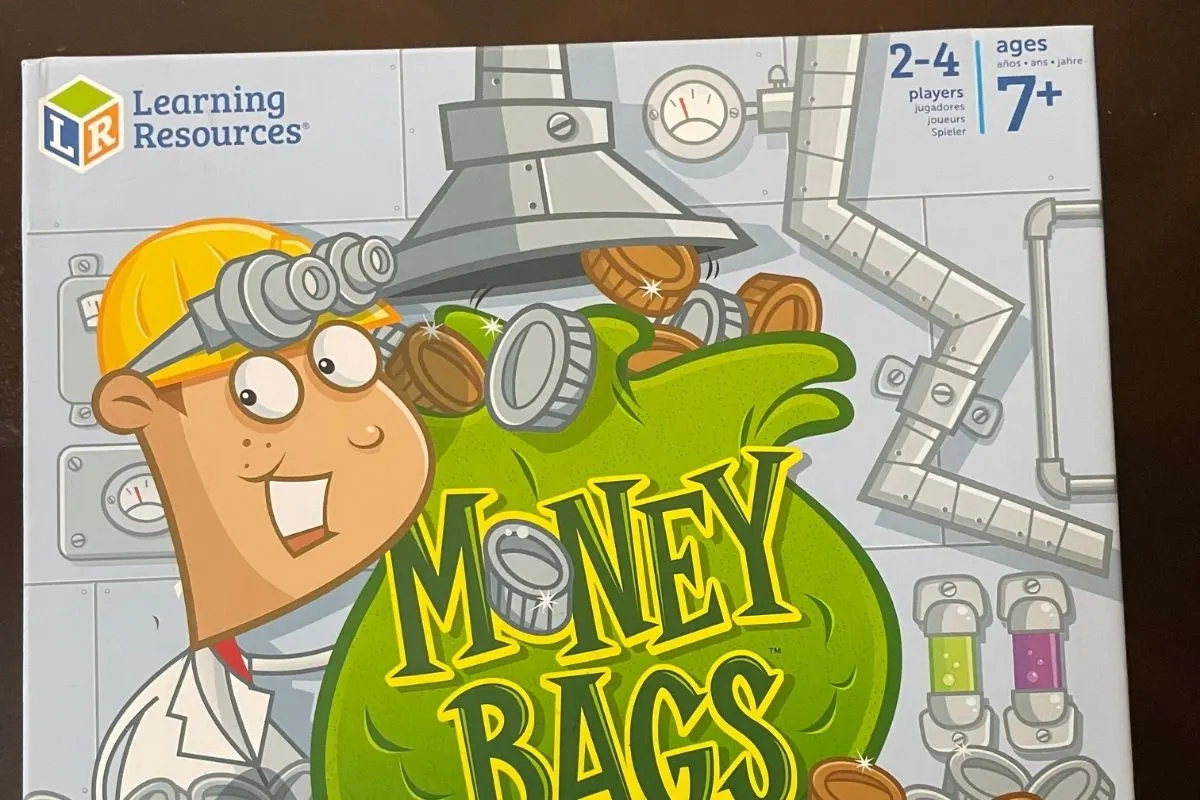
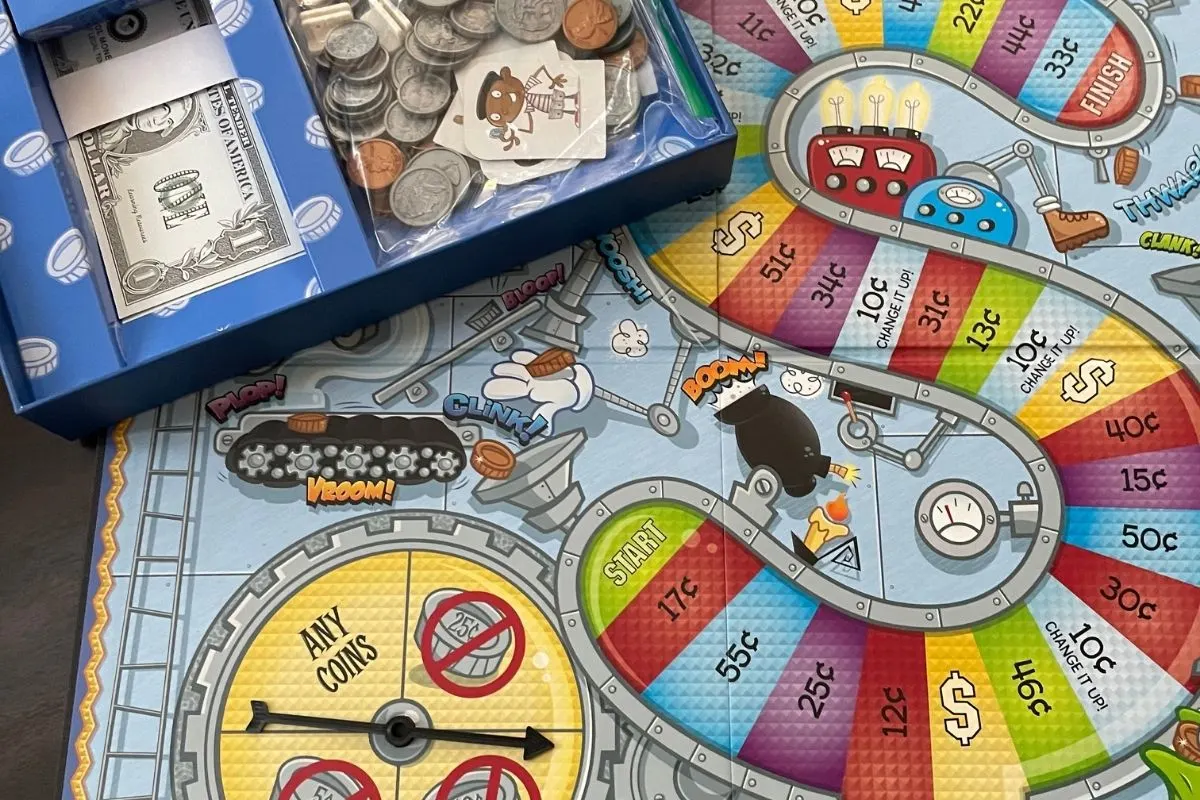
The coin money included in this game is pretty lifelike! I like that a lot – it even sounds a bit like change when you drop it. I’m sure you can use it in other places as well, such as with a cash register, or playing store.
While the player with the most money at the end wins, this game is really not about accumulating money. The actual money lesson here is how to count coins and make changes.
This game really tests their knowledge of being able to count/make change because, on many spins, you have to take money from the bank without using a certain coin. For example, you might have earned $0.40, but you need to be paid out without using any nickels.
Periodically, a player will land on the Change it Up! Space, which means they need to exchange their coins of lesser value in for coins of greater value.
Best Money Games for Kids #2: Quick Pix Money
Suggested Age Range: 7+ years
Players: 2-6
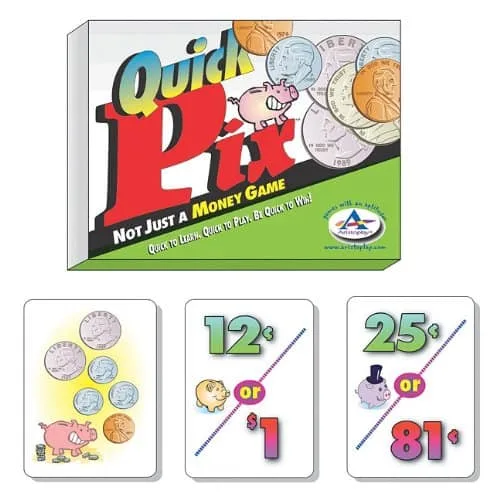
If you’re getting tired of UNO or Go Fish for card games, then check out this one – not only is it fun and as fast-paced as your kids are ready for, but it also teaches coin recognition and money math!
There are two separate decks – an “Answer” deck and a “Problem” deck. Each player receives 5 cards from the “Answer” deck, and a Problem card is turned over every turn. Players race to be the first one to put an Answer to the Problem. An example is a Problem card that has an image of 4 quarters on it. The first person to put their $1 Answer on top of it takes the card. The winner is the first person to win five matched sets by correctly (and quickly) placing the right answer onto the problem card.
Of course, multiple players may have the right answer at the same time, so the quickest person to identify + place their correct answer card down will win the match!
Best Money Games for Kids #3: The Price is Right
Suggested Age Range: The whole family can get involved in some way
Players: 2+
Looking for free money games for kids?
Okay, okay – technically this one is a free group date created by The Dating Divas. But you know what? I think it would work perfectly for kids/family group dates as well!
You’ll probably find it funny to see how much your kid thinks common household items cost at the store. What are they going to guess for a bottle of Advil? How about a can of Campbell’s Chicken Soup?
Each player gets their own card and must estimate how much they think each product costs on the card. Then, you head on out to Walmart, or Target, or do online shopping to find the actual products and record the real price. See who was closest, without going over!
What a fun way to add a little awareness into your kid’s lives about the cost of items they use every day. And you know what else? This could double as a great way to keep the kids engaged (re: occupied) during your next grocery store outing.
Now THAT will make the other shoppers turn and look when they hear the screaming!
Category #2: Learning to Save Money/Budgeting Games for Kids
This collection of budget money games for kids includes teaching core lessons on how to save money, how to budget money, and how to manage money.
Best Money Games for Kids #4: Act Your Wage! Board Game
Suggested Age Range: 10 years+
Players: 2-4 players
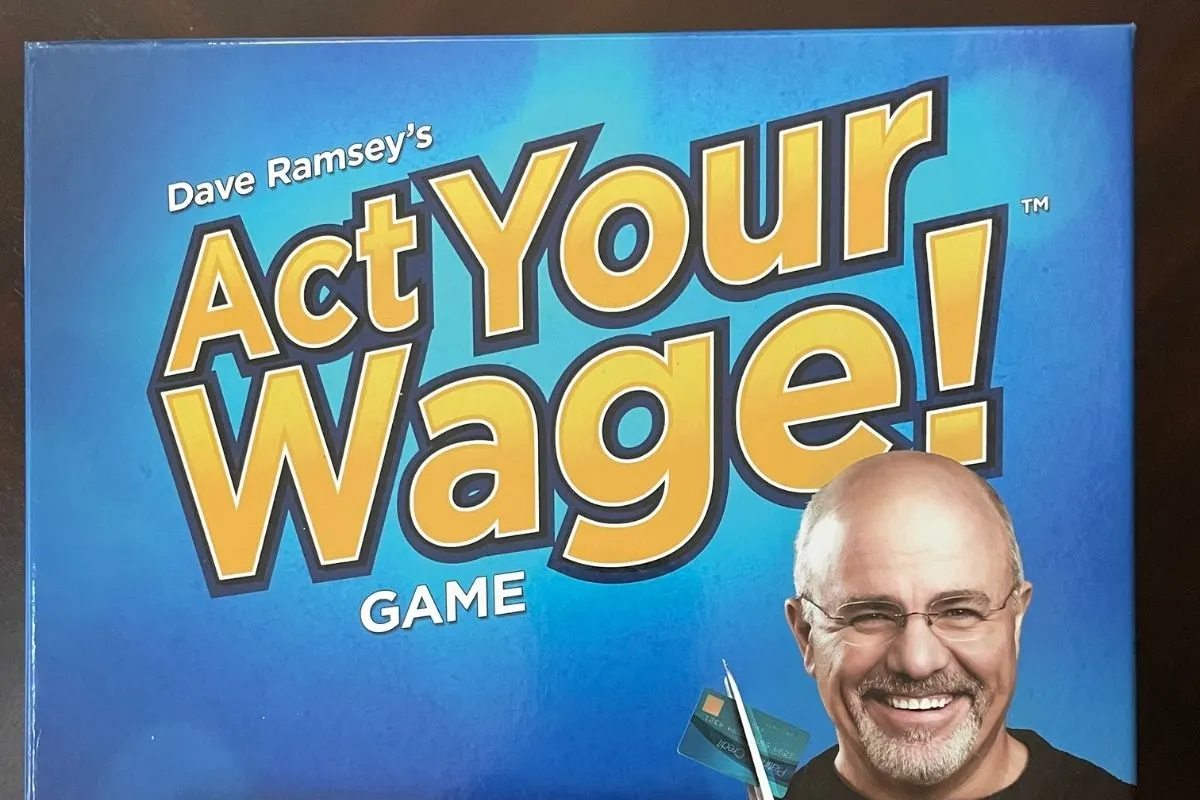
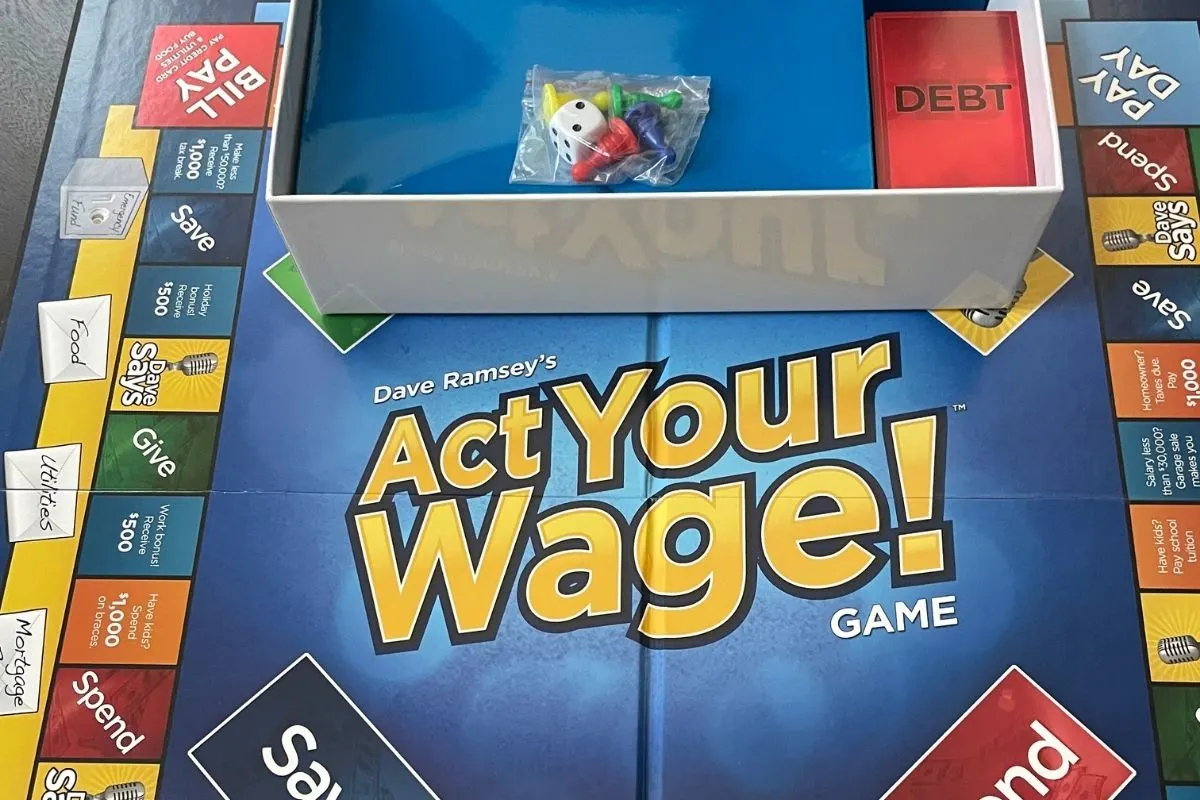
What makes this game very interesting: not only is each player given a life persona that dictates the resources they've got throughout the play, but also everyone starts off in debt.
*womp, womp*.
Players choose a “Life” card, and three “Debt” cards to begin the game. For my round, I was given the following:
- $6,000 in student loan debt
- $6,000 in student loan debt
- $5,000 in business loan debt
Yikes! That's $17,000 in debt to start, which feels slightly overwhelming.
Pssst: However, it didn't feel as overwhelming as when I had my college exit interview with the financial aid department and found out I had around $36,000 in debt (all paid off, finally, in September 2010).
And the “Life” I was given by this game was an engineer who makes $106,000/year and is married with three kids. My paycheck is $4,100, our mortgage is $1,700, our utilities are $600 (that seems really high!), and our food cost is $500 (that seems a bit low for five kids).
Continuing to follow along with Dave's Total Money Makeover Plan (a great read, by the way – here's my own experience following parts of that plan in real life), each player is given $1,000 for their Emergency Fund, and an initial paycheck amount.
Then, it's up to each player to decide how to distribute the money obtained throughout the game between each of their envelopes (budget categories, such as Food, Utilities, and Mortgage/Rent). Along the way, players can also land on spaces where they'll have to pick a “Save”, “Give”, or “Dave Says” card (these are full of Dave-nuggets and “Stupid Taxes”), and they must follow what is on them.
The first person to pay off all their debts and yell “I'm Debt Free!” wins the game.
Best Money Games for Kids #5: Franklin's Fortune
Suggested Age Range: 14+ years
Players: 2-4 players
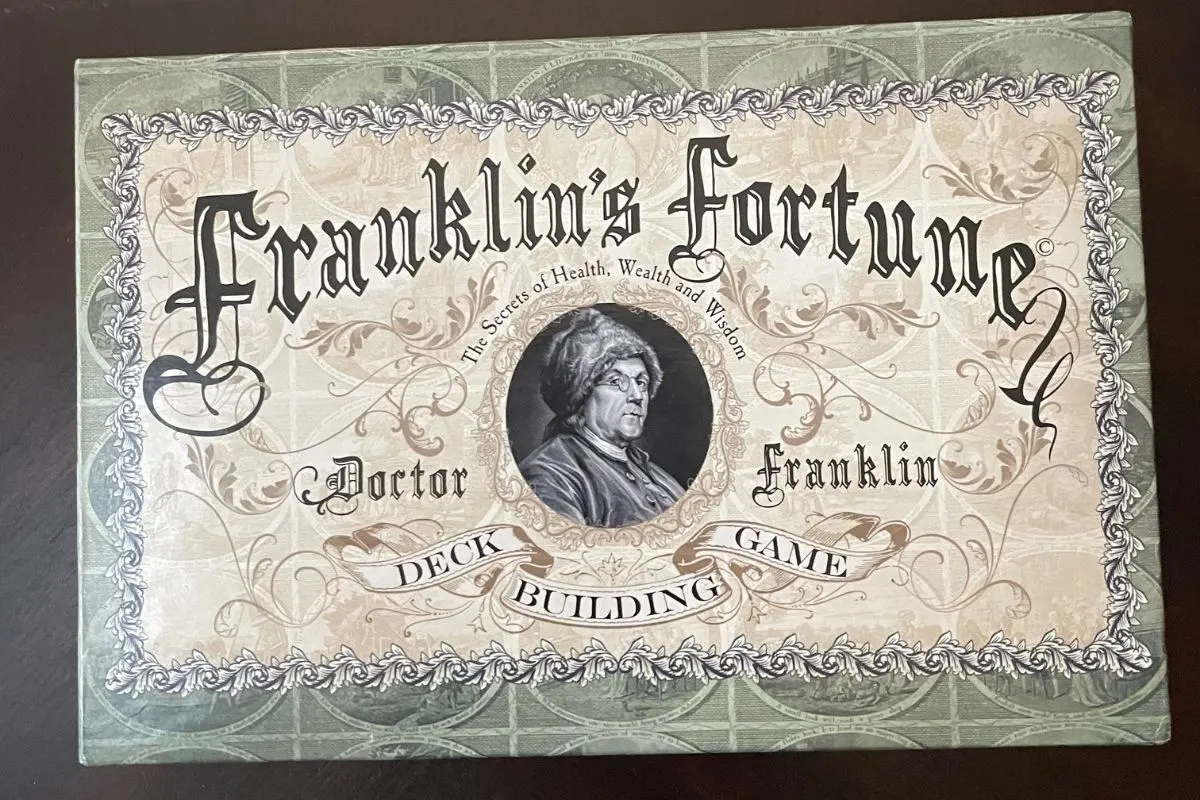
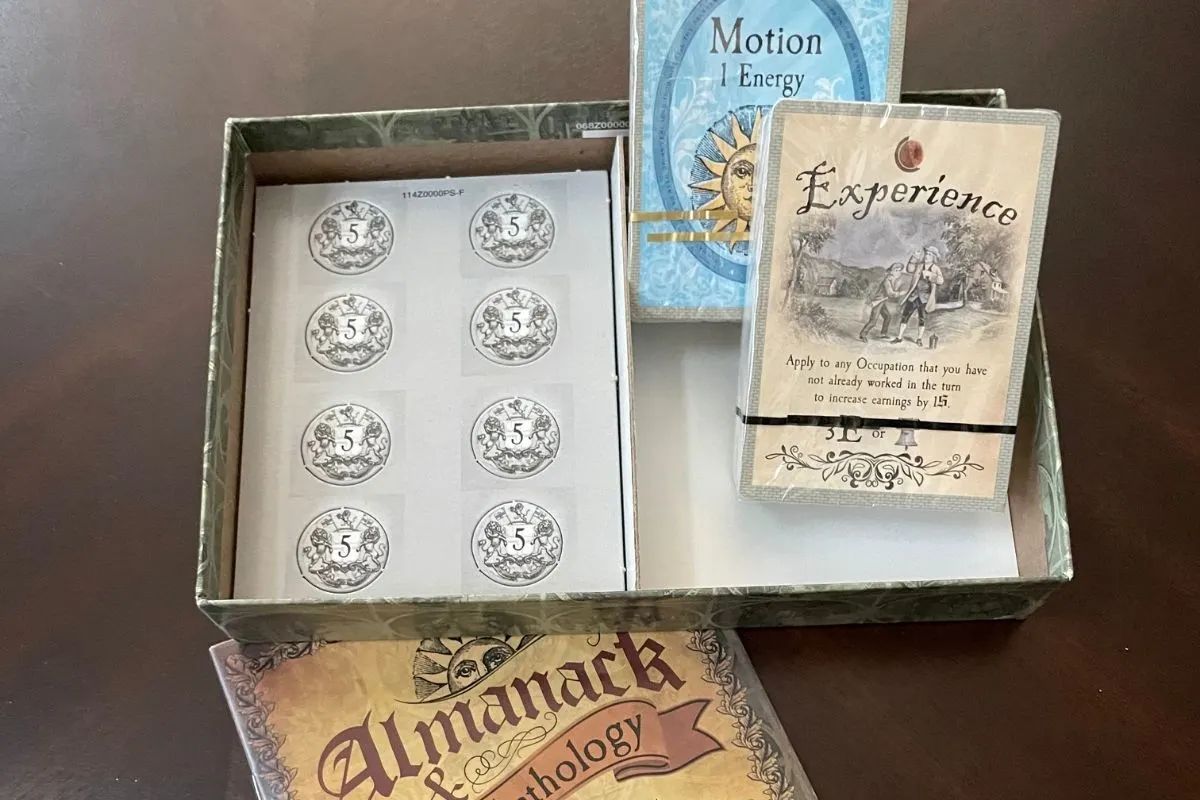
The philosophy behind this game – how best to use your three resources, energy, persistence, and money each day of your life – comes through in this deck-building game.
Players are tasked with finding the secrets of health, wealth, and wisdom through the decisions they make each day (you draw 5 cards at a time, and that represents the resources you have to use for one round of play, which equals one day).
You then use the cards from your hand to either acquire a card from the commons or to acquire money. Points (which determine who is the overall winner) are scored by balancing acquiring things like persistence as well as money.
Each occupation type (tradesman, proprietor, and investor) uses a different energy source to work as well as reaps different payments. Players can work their way up by using education and experience cards, ultimately increasing their earnings and winning potential.
I like how building a fortune doesn't just mean gathering the most money in this game. Instead, a fortune also means accumulating things without direct monetary value (that have lots of other value), like education, character traits like persistence, and virtues.
Here's a much fuller explanation video.
Best Money Games for Kids #6: Managing My Allowance
Suggested Age Range: 8+ years
Players: 2-4 players
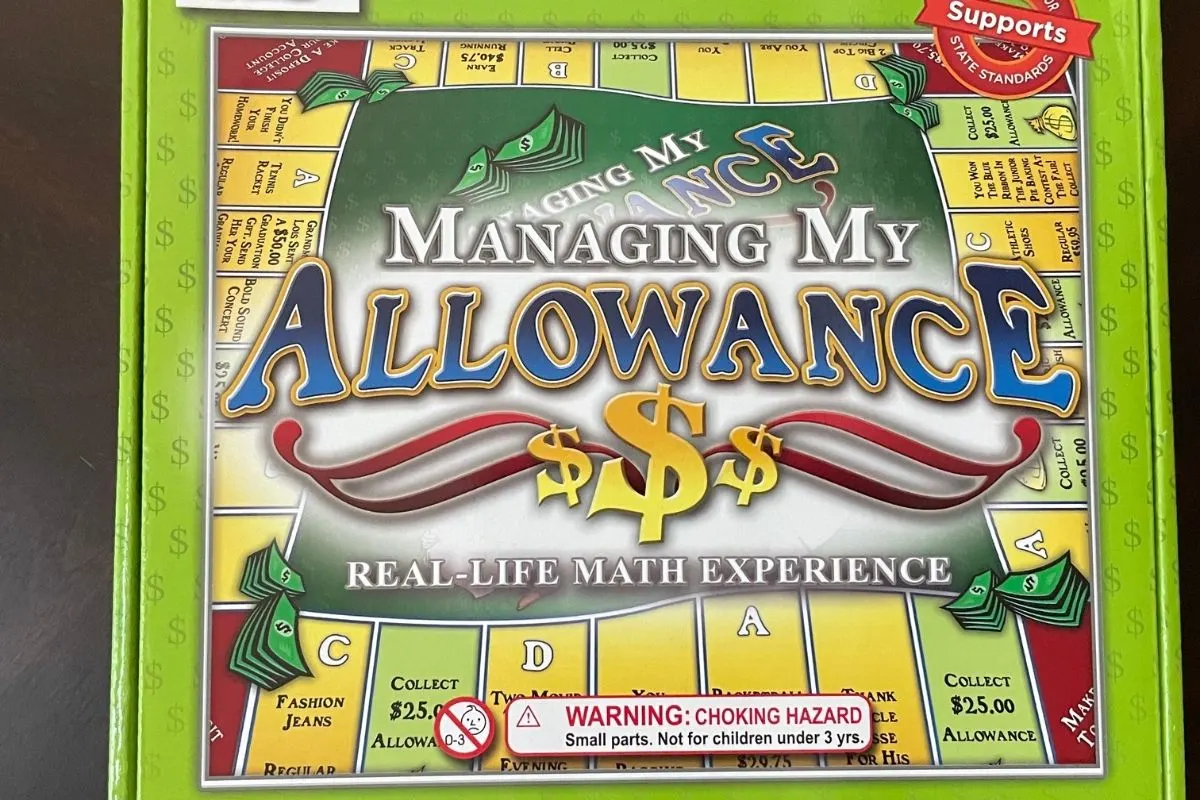
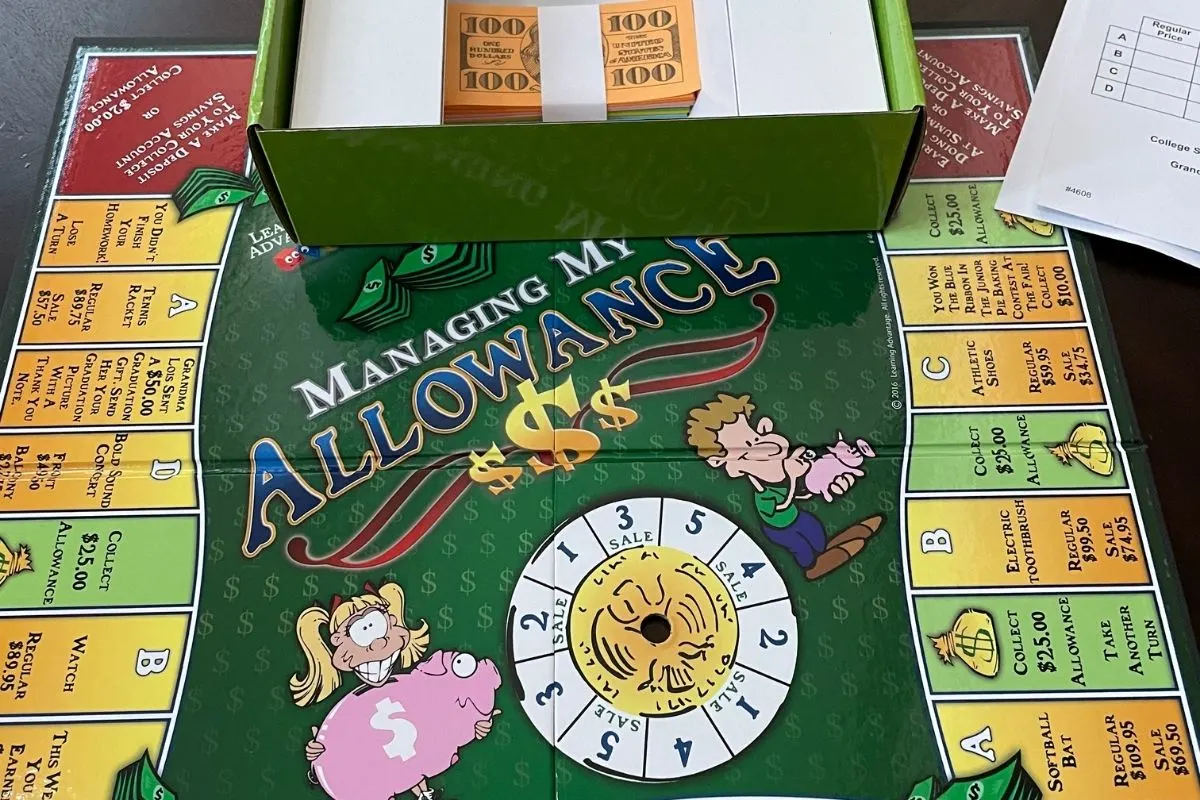
This game is set up to teach your young kids how to manage their allowance by choosing one of two games. Yes, this is actually two games in one – the Allowance Game, and the Managing My Allowance Game.
In the game Allowance, players are working towards saving up for their college education. Each player must also, while saving money, purchase products – one from each of 4 categories. The winner is the player who has made a purchase from one of each of the 4 categories, PLUS, has the most amount of savings in their college savings account (ha! I like reinforcing the concept of saving, and especially of saving towards college!).
In Managing My Allowance, the outcome and basic premise is the same, but with one addition: teaching your kids about sales (versus buying products at regular prices). The winner in this game is the player who has the most college savings AND who has the largest total savings on purchases.
The winner is the player who has deposited the most amount of money into her college savings account
Each player keeps a financial record of their purchases and savings as they move along.
Best Money Games for Kids #7: The Allowance Game
Suggested Age Range: 5 – 11 years
Players: 2-4 players
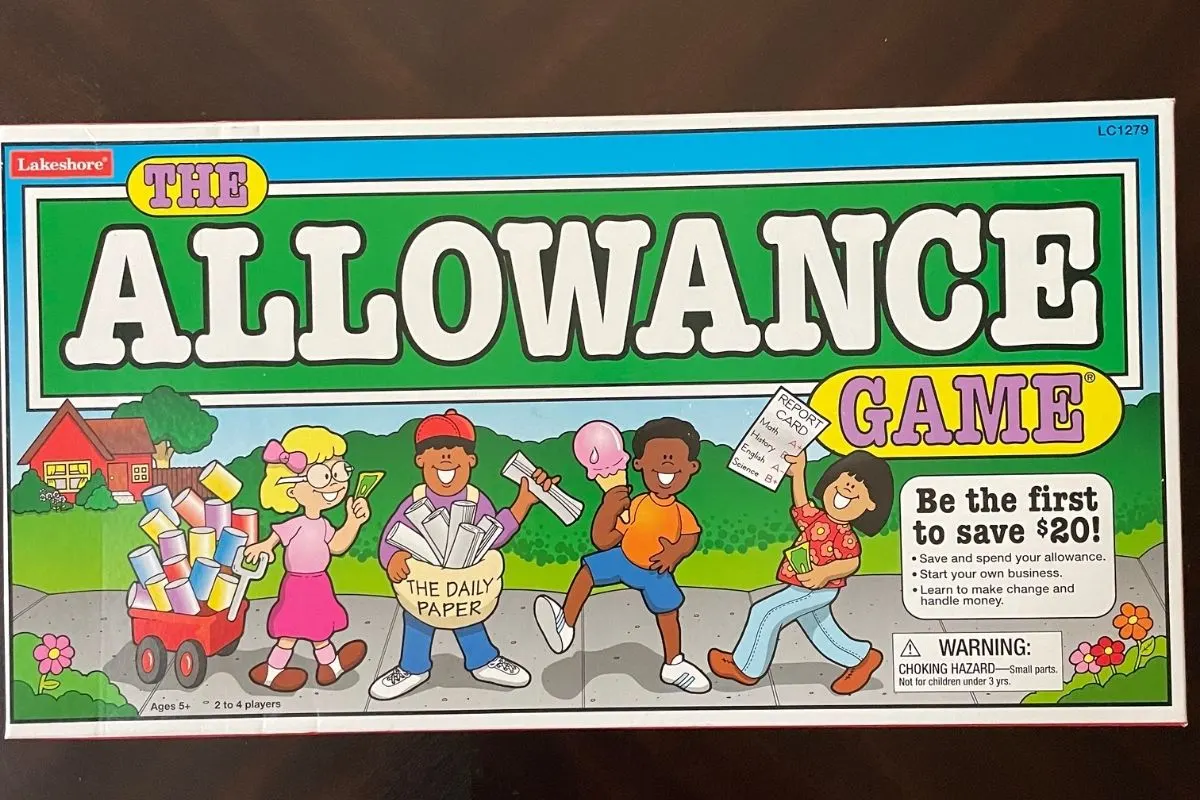
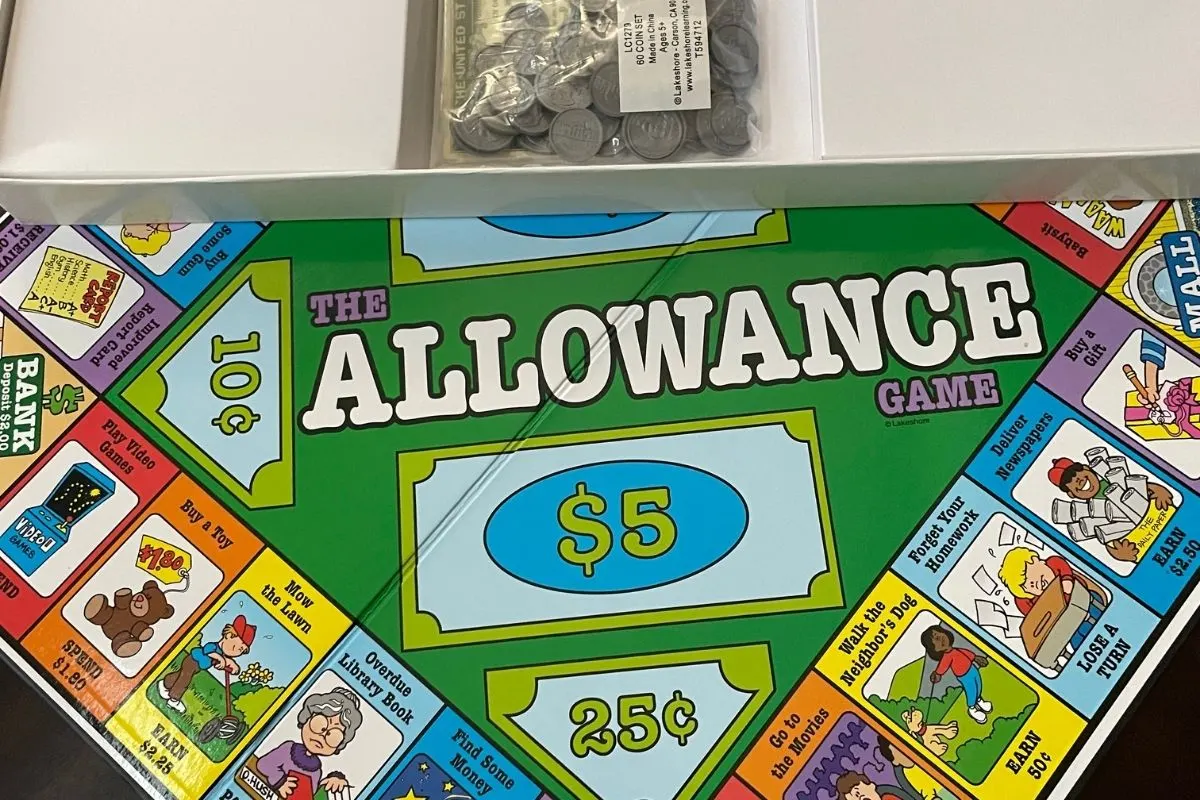
Each child can play their own banker in this game, or you can choose one banker to do the transactions. Speaking of banking…I like how this game has your child earn interest on the money that they keep in the bank!
Allowance is $3.00 (each time you pass the “Home” space), and there are ample opportunities for your child to earn more each turn – doing things like opening up a lemonade stand, washing the car, etc. – and ways for them to spend their money (like at the mall).
Ways to earn money and to spend it are very kid-friendly, meaning there's no real-world budgeting here. For example, receiving money for a birthday, receiving $1.00 for an improved report card, getting $1.00 for losing a tooth, or having to pay a $0.60 library fine, or literally losing $1.50 of your money. However, this means your younger child will be able to really relate to the options on the board.
The goal is for them to work their way around the board and earn enough money to get to $20. That's how you win!
Best Money Games for Kids #8: Moneywise Kids
Suggested Age Range: 6-12 years
Players: 2 players
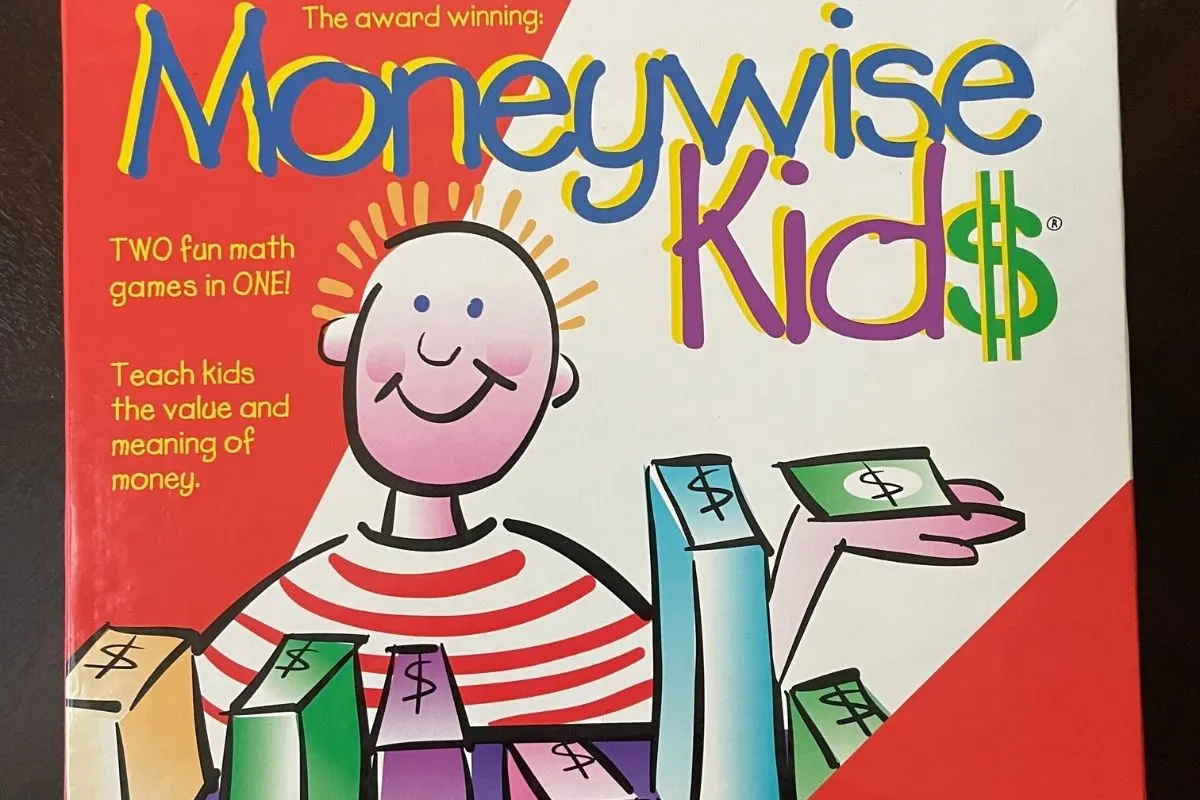
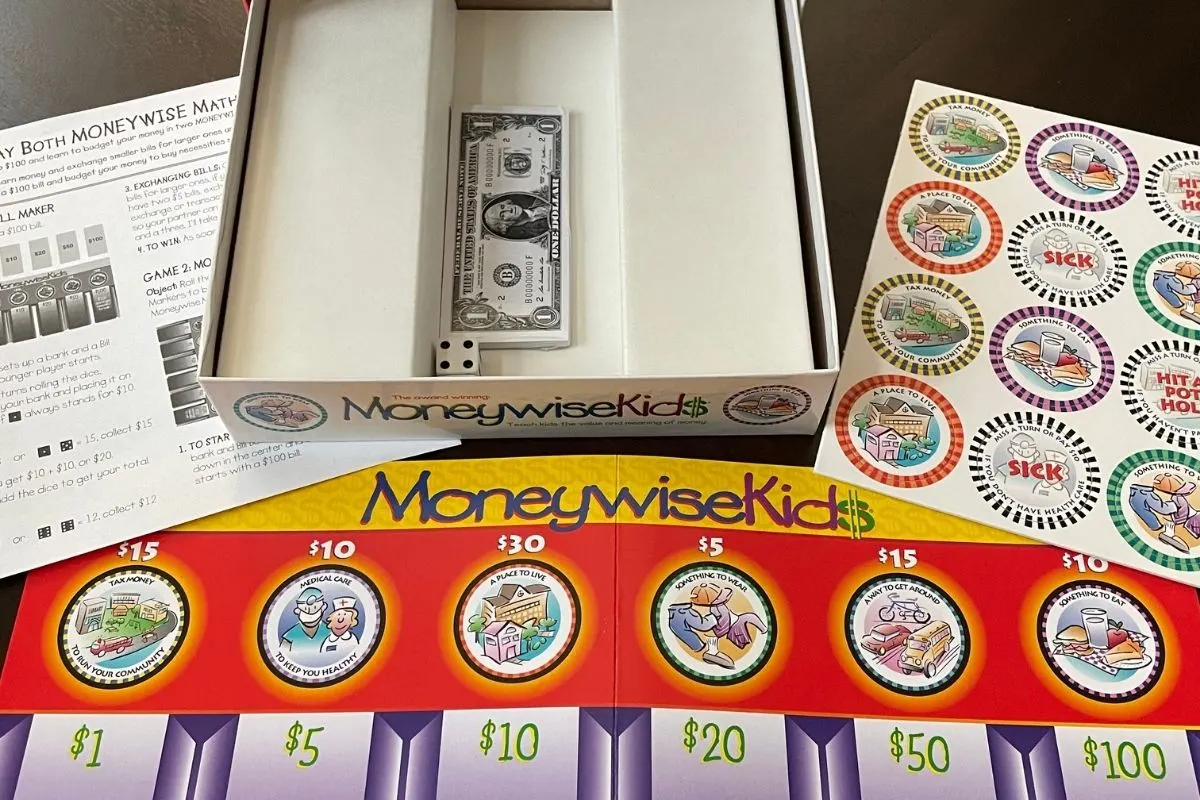
This is an award-winning Money Math Game that teaches kids money math, as well as that bills, are monthly through two different games:
- Game 1 – Bill Maker: Each player takes a turn rolling the dice and collecting money (sounds nice so far, right?). During your turn, you then need to trade up your money to the highest denomination you can get. So, for example, if you have five $1 bills, then you can trade them in for a $5 bill. With two $5 bills, you trade them into the banker for a shiny $10 bill. The winner is the first person to work all the way up to a $100 bill.
- Game 2 – Bill Breaker: There are 6 markers that each player needs to purchase, with each marker being a bill of some sort (such as “A Place to Live,” “Something to Wear,” and “Medical Care,”) PLUS put $100 into your savings. The first person to do so wins.
Bonus: Check out the back of your boards for concrete ways to make real-world connections to the monthly bills discussed in the Bill Breaker game.
Best Money Games for Kids #9: Budget – Real World Math
Suggested Age Range: 9 years+
Players: 2-4 players
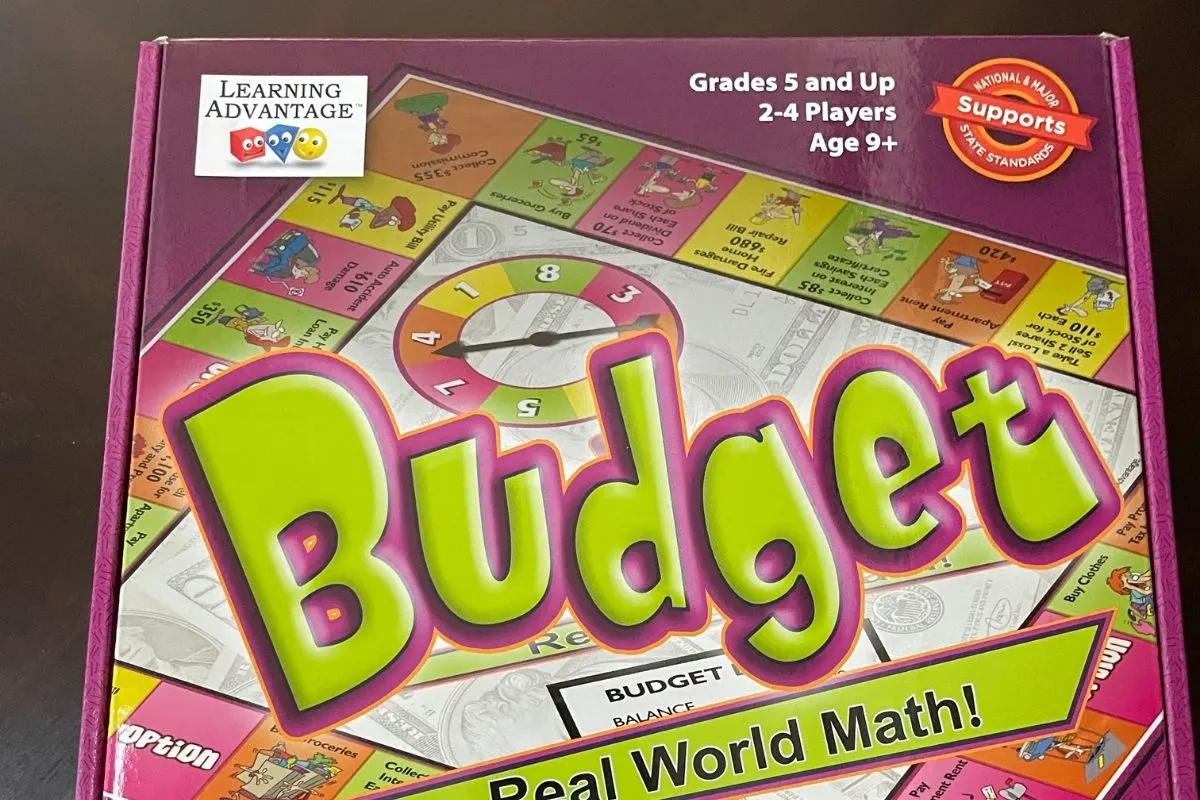
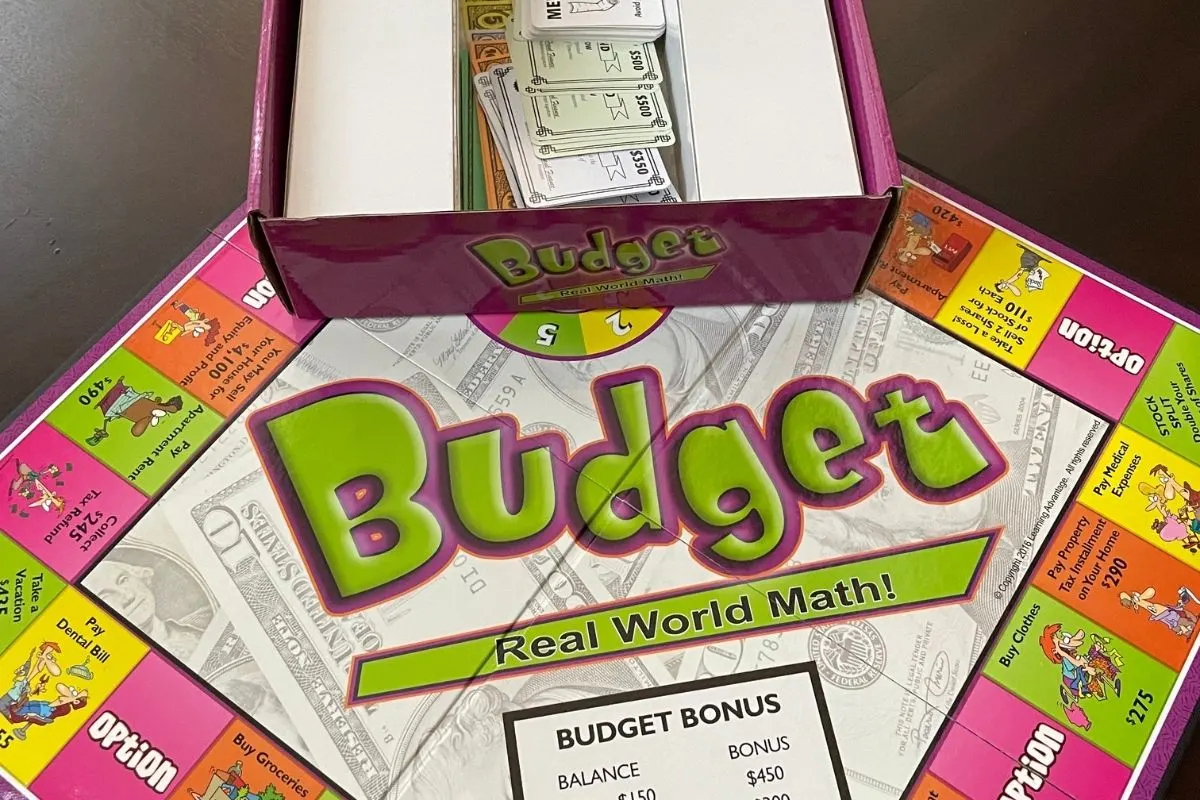
Budget is a game all about, well, budgeting! Except this is budgeting with a twist – players have to determine how much they think they'll need to cover their budgetary expenses each time they pass Payday. And players who are accurate with their budget “predictions”, will actually earn a budget bonus.
But if there's not enough money in the budget they set aside to pay for everything before the next payday? Then there's no budget bonus (I like how players can adjust their budgets every payday and essentially learn how to predict their expense needs better!).
The first player to reach $6,000 in net worth, wins.
Players start with $2,500 each, and a player can land on the following types of spaces: purchase options, earnings, or expenses.
FYI: this game touches on investing, as well. It gives players the ability to purchase investment options (Savings Bonds and Stocks) when they land on option spaces. Saving Bond owners will collect interest, and holders of stock will collect dividends, benefit from stock splits, and might even lose money when they have to sell shares that have fallen below the cost at which they purchased. Also, real-world math (aside from the budgeting part) includes players figuring out probabilities of landing on certain spaces on the board.
Note: you'll need additional setup to play this game – it comes with a “Financial Record” sheet that you'll need to make a photocopy of for each round of play.
Best Money Games for Kids #10: Payday – Classic Edition
Suggested Age Range: 8 years+
Players: 2-4 players
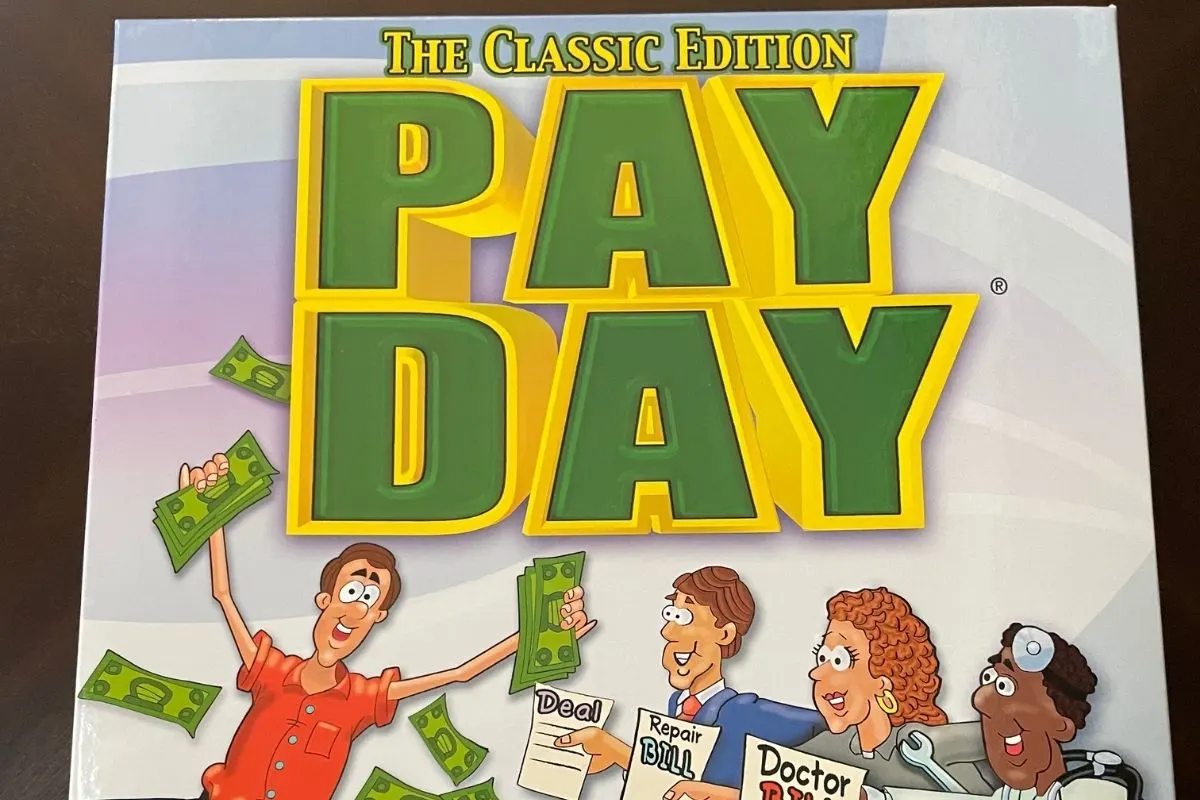
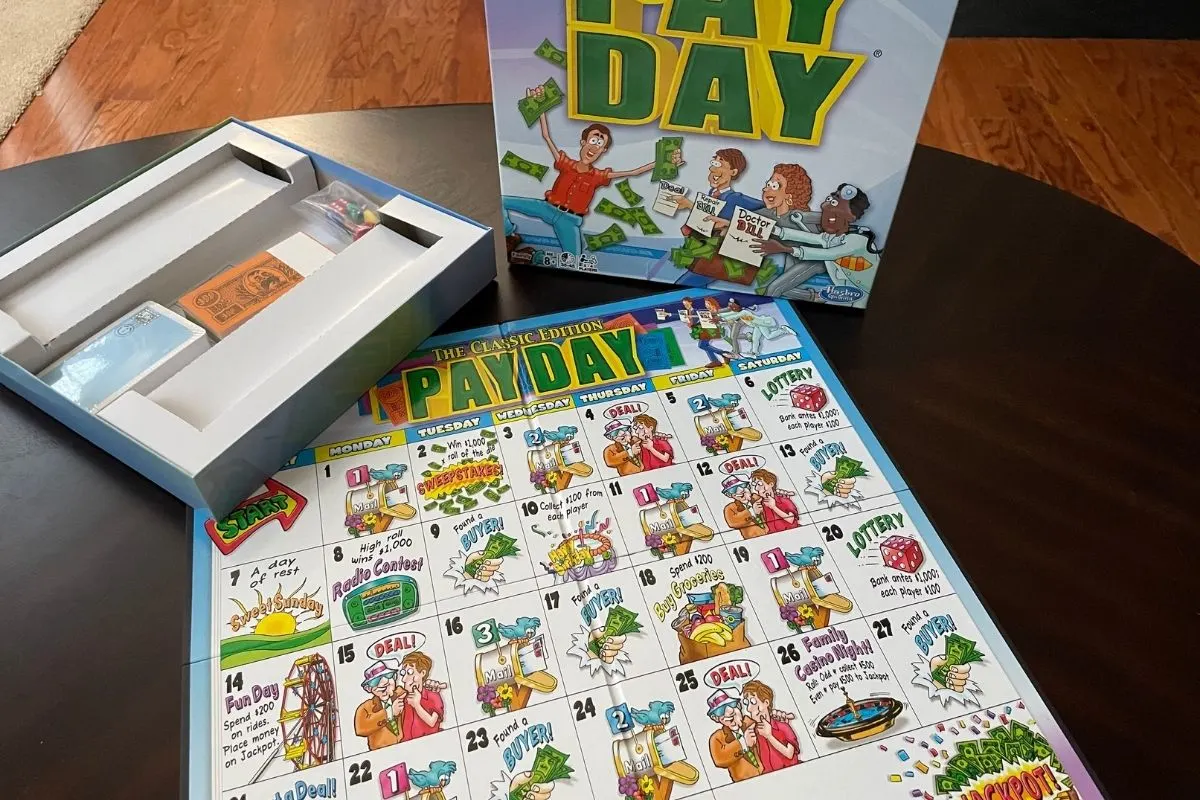
Who doesn't like Pay Day?
But Payday loans? Not so much.
This game allows kids to go through the cycle of paydays and monthly bills (with a 2-month game taking under an hour to play, and a 6-month game taking about 2 hours to play), including the likelihood that they'll be taking out payday loans with a steep 10% interest due on…you guessed it, their next payday.
One player gets to act as Banker, and gives each player a whopping $3,500, to begin with (they actually get two $1,000 bills!). Another player gets to be the Loan Record Keeper, and they must keep track of all loan transactions.
Players accumulate mail throughout the game, then on Payday, they must open up their mail and pay all their bills. Players also get the option of giving loans out to family and friends and purchasing “deals” (even if that means taking out a loan to do so). The reason why they're called Deals? Well, they just make the player a profit when they land on a “Found a Buyer” space. Then again, they might not.
Monthly salaries are $3,500 each (not too bad!). The winner at the end of the agreed-upon number of months is the player with the highest net worth (or, the player with the least amount of debt in the event that everyone has gone crazy and has tons of debt…which could happen with this game).
Category #3: Fun Financial Games to Learn Investing and About Wills
Dying to teach your kid how to invest (but maybe not so confident on how to do so, or how to start)? Here are some board games to help, both younger aged and older aged kids.
Best Money Games for Kids #11: CA$HFLOW for Kids
Suggested Age Range: 6+ years
Players: 2-6 players
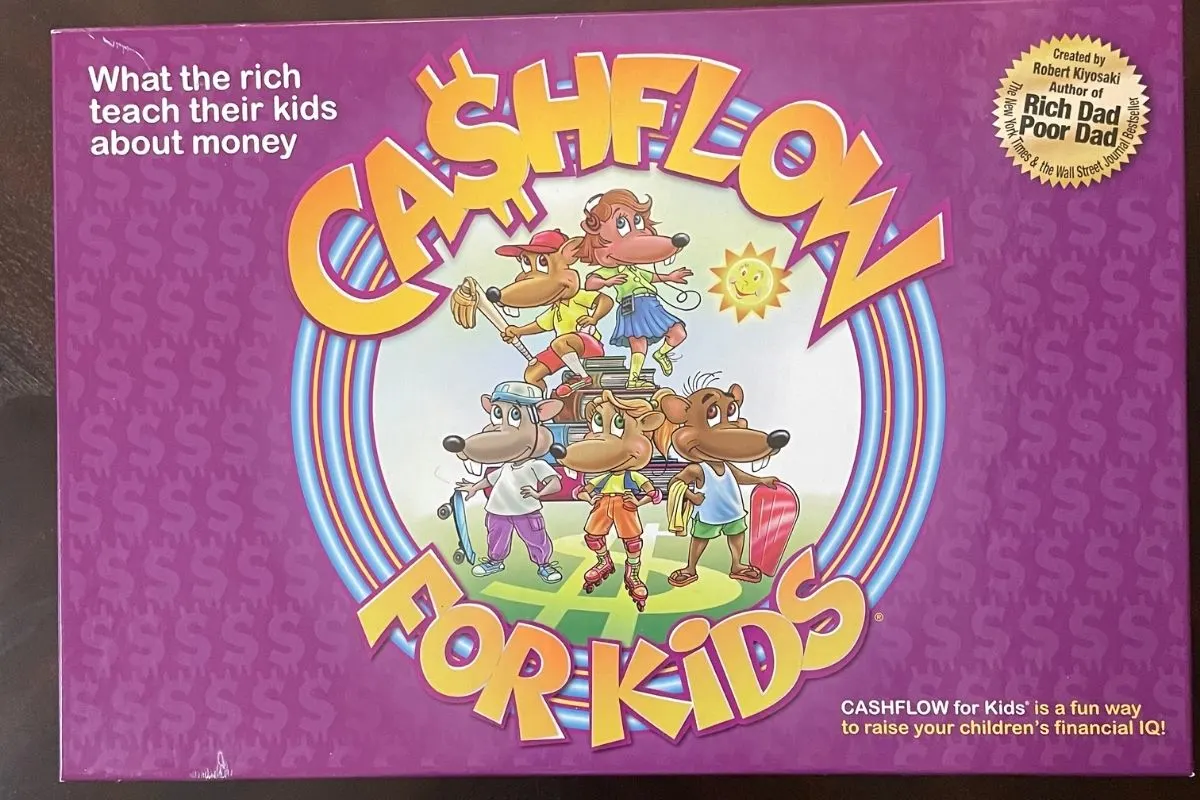
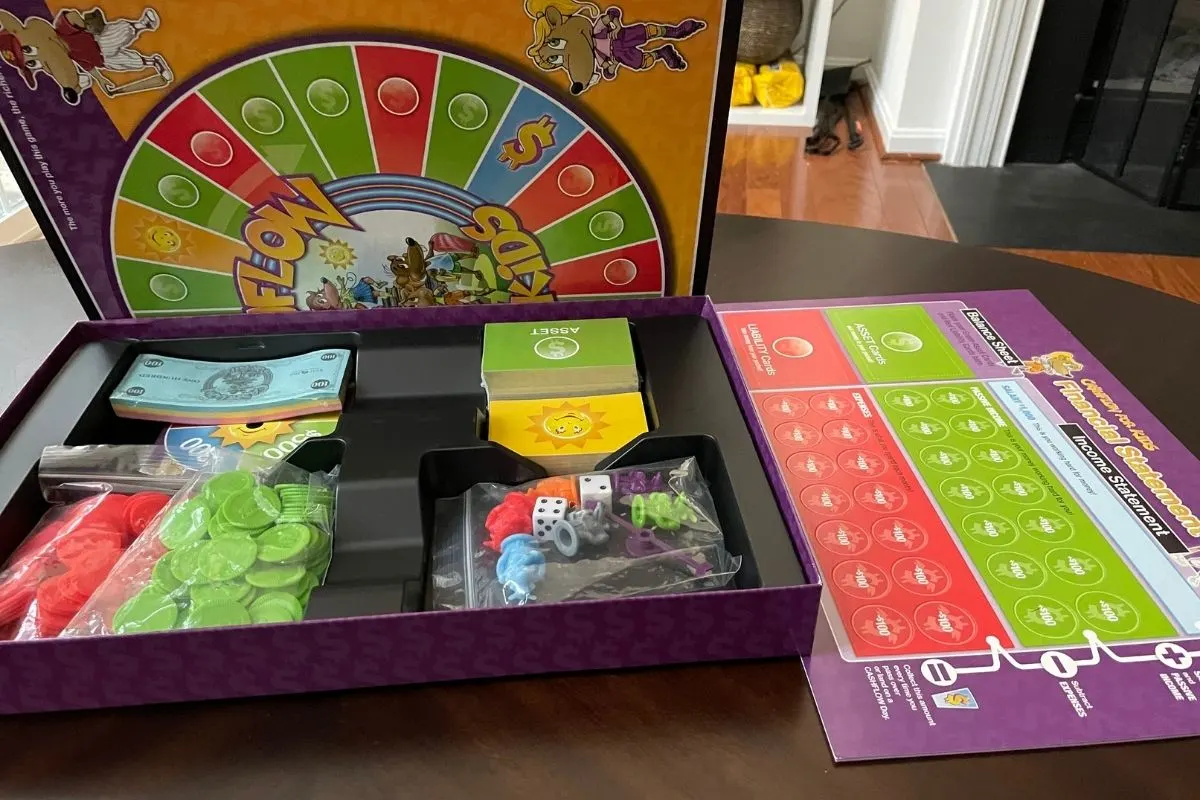
If you’ve ever read Robert Kiyosaki’s Rich Dad, Poor Dad book (an eye-opener, that’s for sure), then you’ll probably be excited to know he’s got a game that will teach your child some of those Rich Dad things.
Namely, to put as much money as you can towards building assets, and as least as possible towards creating continuous liabilities. Also, create passive income streams that exceed your expenses (first by a little, then by a lot!).
This game sets out to teach your younger children the relationship between their balance sheet, and their income statement. What that boils down to is this: you want to make sure your assets + passive income is greater than your liabilities + expenses.
I love how each player gets their own Financial Statement sheet in this game (that includes a side for the balance sheet and a side for the income statement). Cards are divided up into three piles: assets, liabilities, and sunshine cards.
Just an example of a decision your child gets to make: to pay $500 cash for a video game system upfront or to charge it and pay $100/month.
One kid gets to be a banker, just like in Monopoly, and everyone starts the game out with $3,000. The winner is the first person to create passive income that is greater than their expenses.
Best Money Games for Kids #12: Stockpile
Suggested Age Range: 13+ years
Players: 2-5
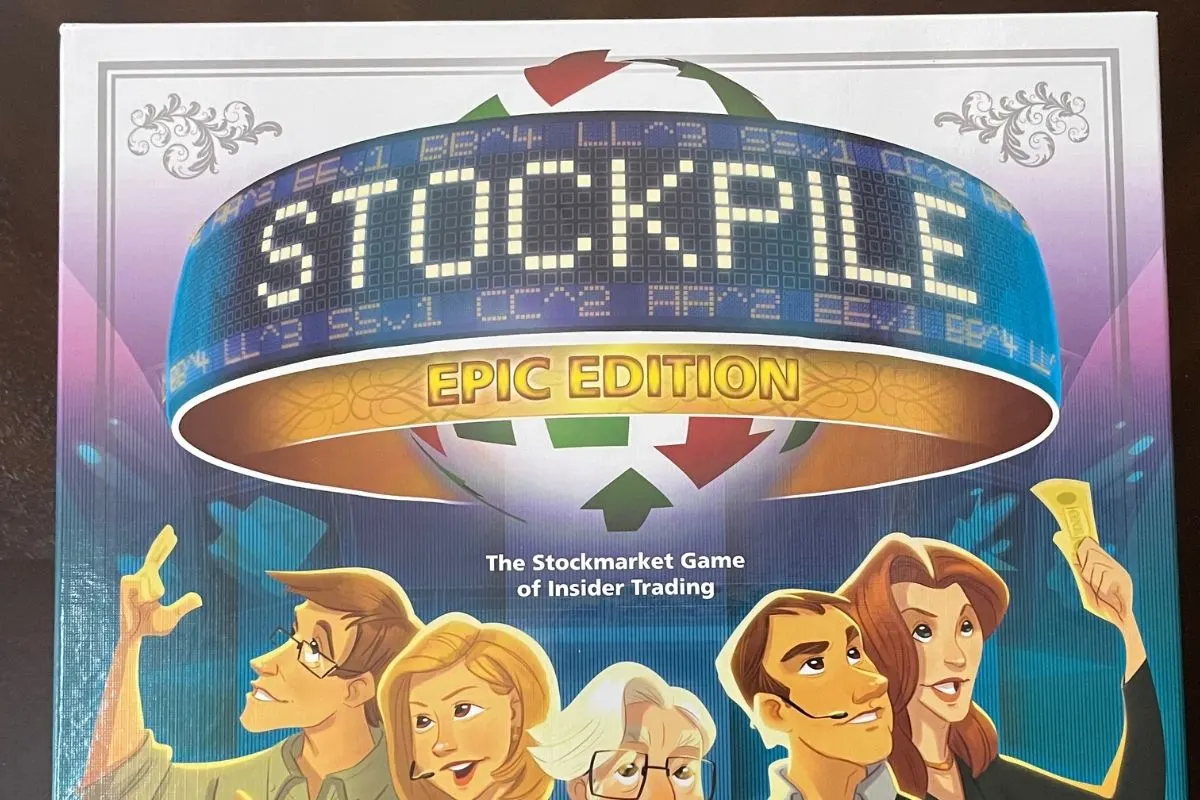
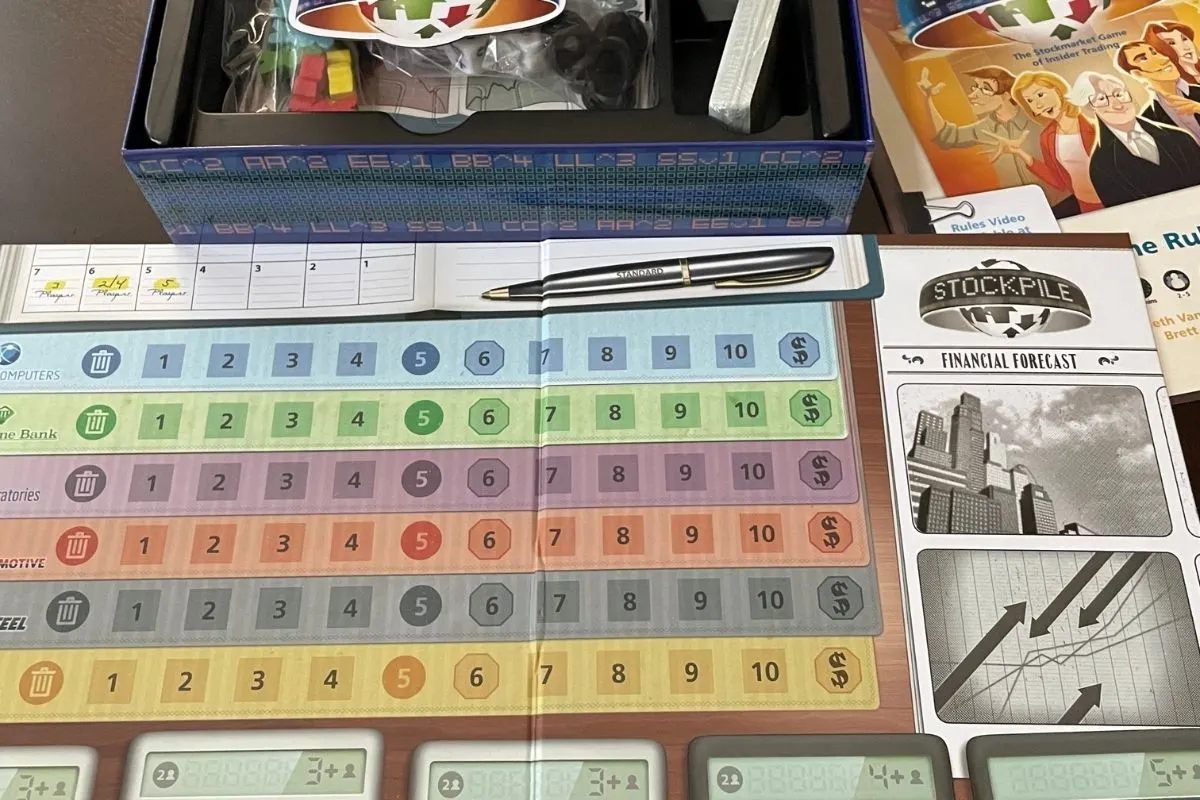
Sometimes you can learn the most about a subject by learning how you – and others – can manipulate it to your advantage.
Like, the stock market.
The game Stockpile gives teens the ability to see what insider information can do when trying to buy stocks in the stock market.
There’s both public information and private secrets each player is given as they work through the game.
The six different types of stocks in play are:
- Cosmic Computers
- Bottomline Bank
- Leading Laboratories
- American Automotive
- Stanford Steel
- Epic Electric
Each stock begins at the stock price of “5”, and each player begins with a stock portfolio plus $20,000 from the bank.
The goal of the game is to buy stocks at good prices and sell them at higher prices so that you have the highest net worth in the end.
Get loads more information, here:
Best Money Games for Kids #13: Big Money
Suggested Age Range: 8+ years
Players: 2-5 players
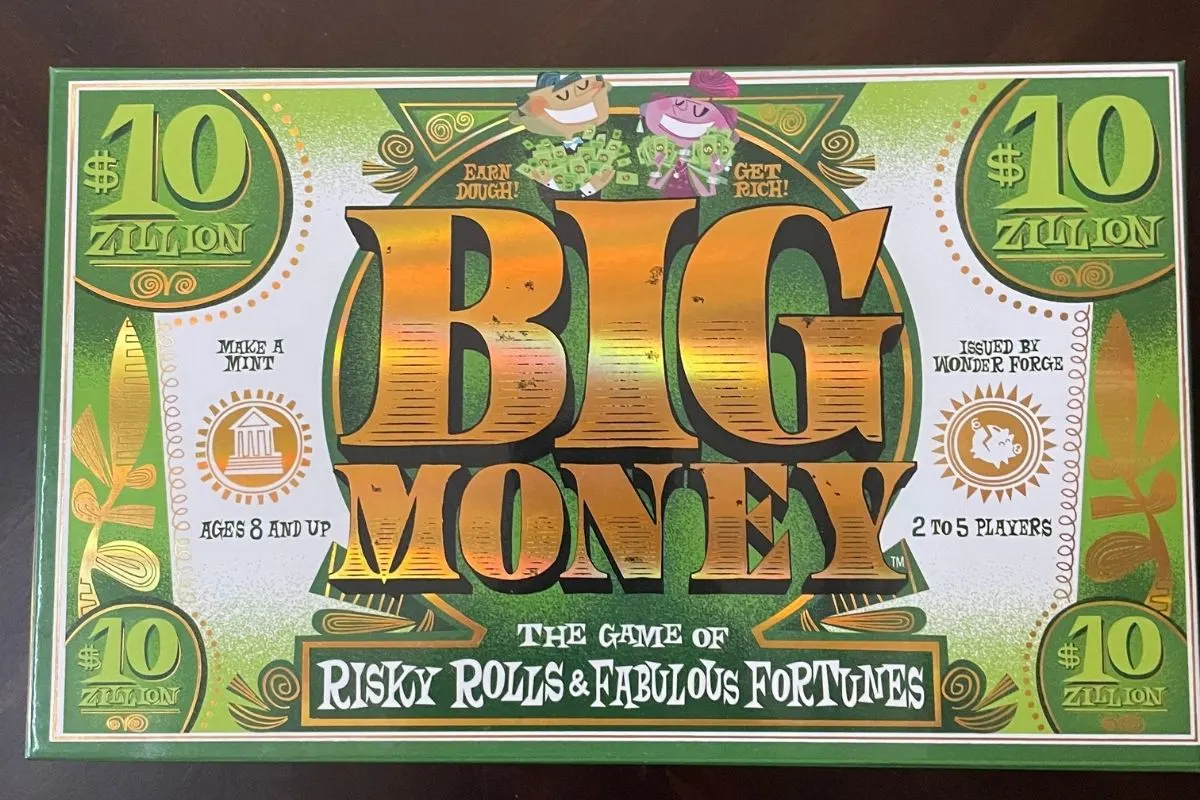
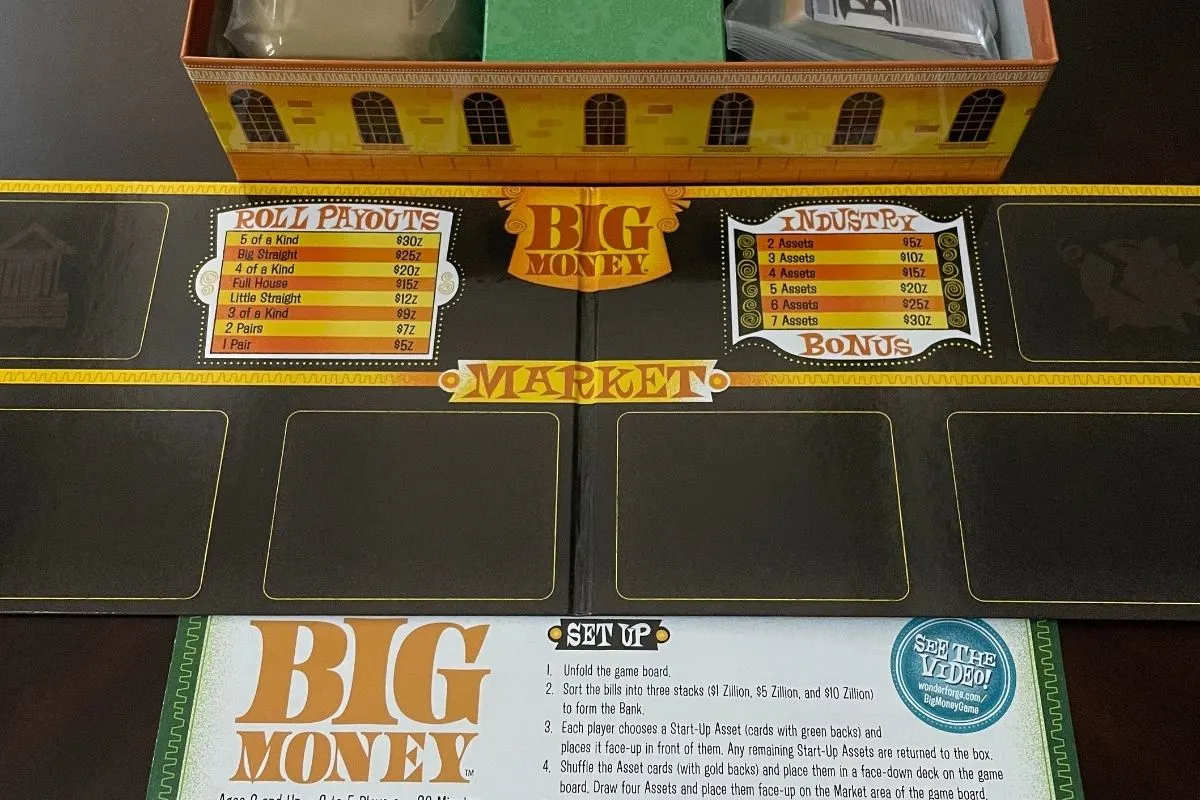
The goal of this game is to finish with the most cash.
Players are given a start-up asset to begin the game with, and with each turn, they roll the number dies and the industry dies. If the industry dies match the asset pictured on your asset card? Then you get paid. The more assets you own (and you can buy them as you go), the bigger the payout you get.
Assets are really fun, like:
- Private Island Resort (yes, please!)
- Major Movie Studio
- Pro Soccer Team
- Stock Certificate
- Monster Truck Show
Buuuuut…there's also risk involved (isn't that how the real world works, too?). Because with each roll of the industry dies, you might get the “Biz News” picture and have to draw a Biz News card.
Bad Biz News includes things like:
- Global Recession
- Antitrust Fine
- Technology Crash
- etc.
I love how this really opens up your child's awareness of what people own as “assets”, as well as how bad business news can affect assets.
Best Money Games for Kids #14: 13 Dead-End Drive
Suggested Age Range: 8+ years
Players: 2-4
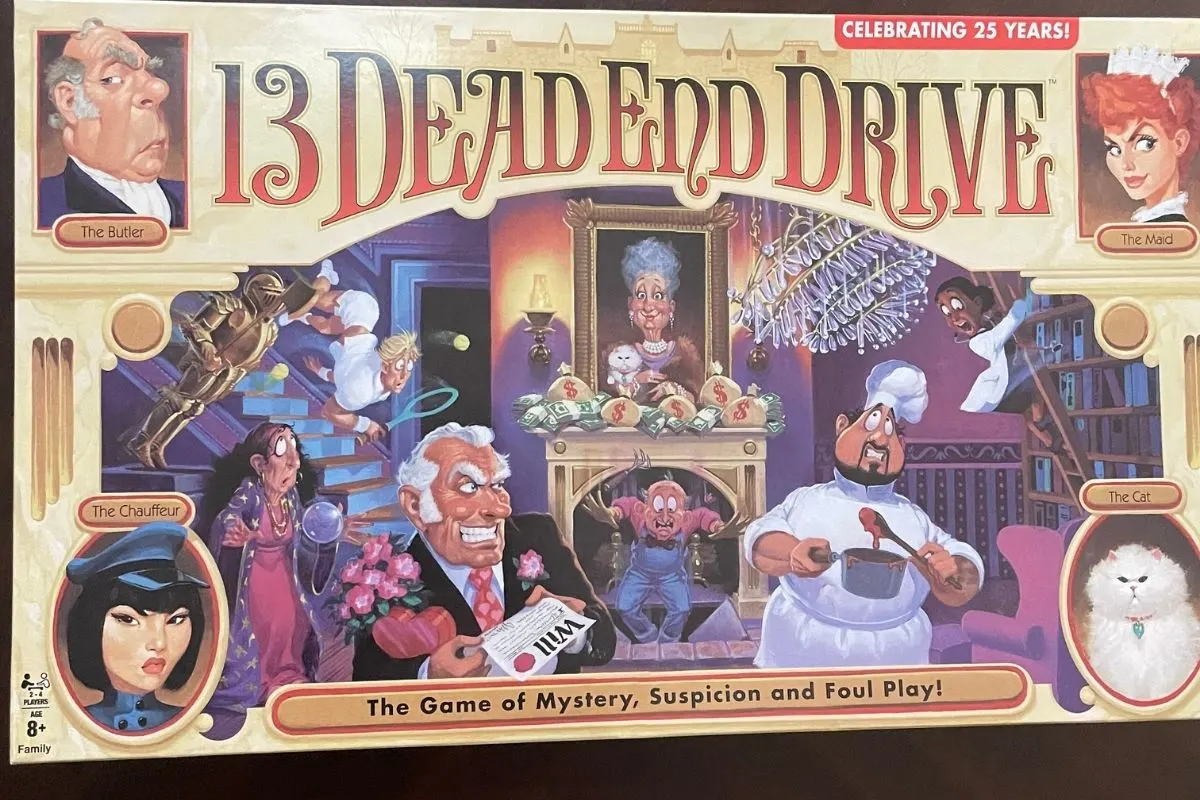
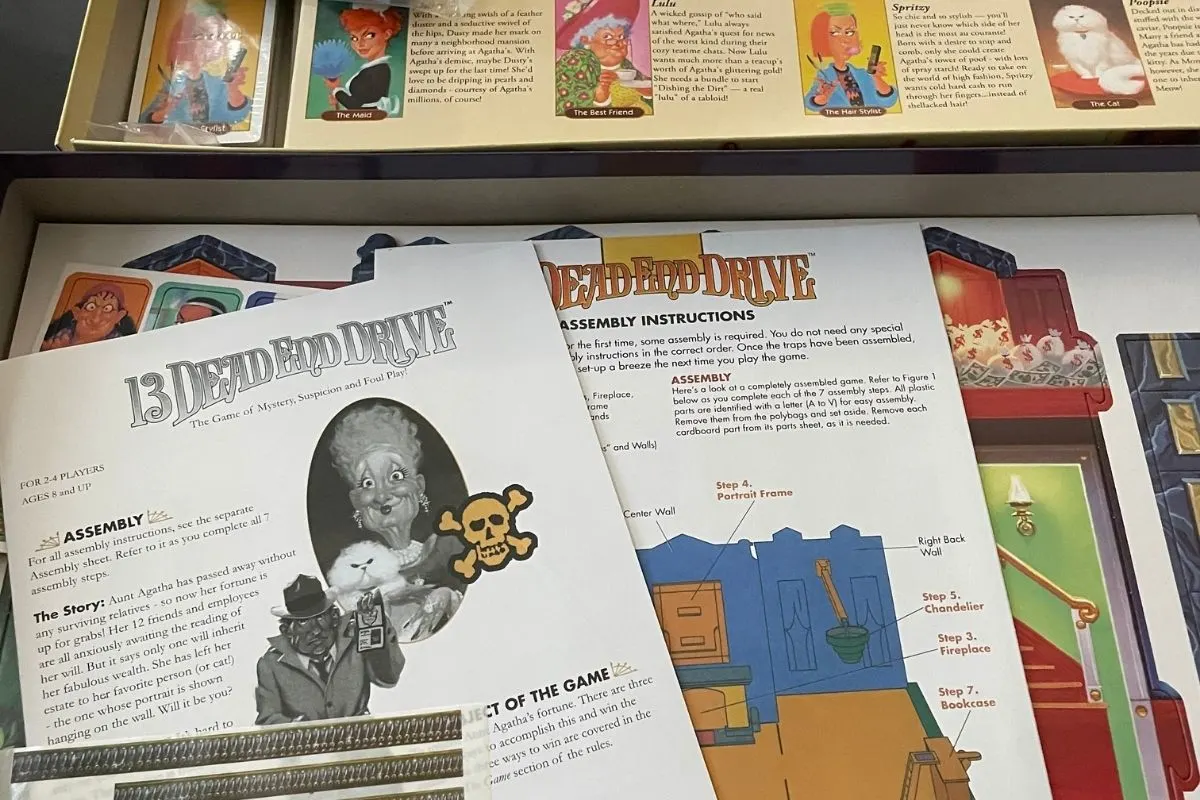
Ever wanted to teach your kid about wills, inheritances, and greediness? Well…this is your game.
Hint: if you haven't gotten your will in order yet, you might think about getting started with that after playing a round of this 25-year-old game!
Poor Aunt Agatha has passed away, leaving a sizable fortune without any relatives to pass it on. There are 12 different friends and employees waiting to hear the reading of her will, but only one of them can inherit her fortune.
There are booby traps to take out as many of the 12 people as possible, such as the chandelier comes crashing down on a pawn (quite literally, as you push the lever on the chandelier and it releases!), flinging a character down the stairs with a flick of your finger, and having a pawn come to an abrupt end when a statue topples over them.
Cutthroat, man.
The three ways you (the player) could be the one to inherit everything are:
- Your character is the portrait hanging on the wall and you land on the Game Over space.
- The detective reaches the game over space and the portrait hanging on the wall matches one of your surviving pawns.
- Your pawn is the “last one standing.”
Somewhat morbid? Yes. It's pretty fun, though.
Category #4: Entrepreneurial Money Games
Finally, let’s discuss money games that help teach kids to become entrepreneurs.
Best Money Games for Kids #16: Mystic Market
Suggested Age Range: 10+ years
Players: 2-4 players
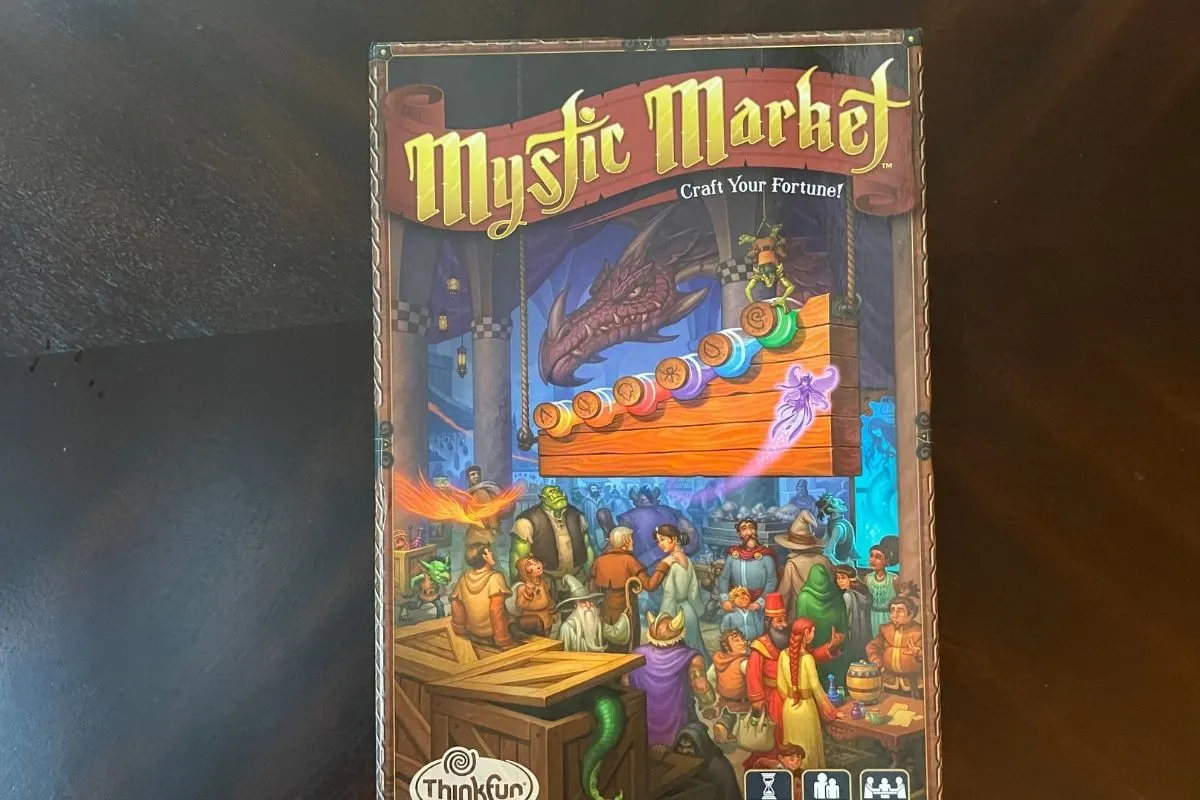
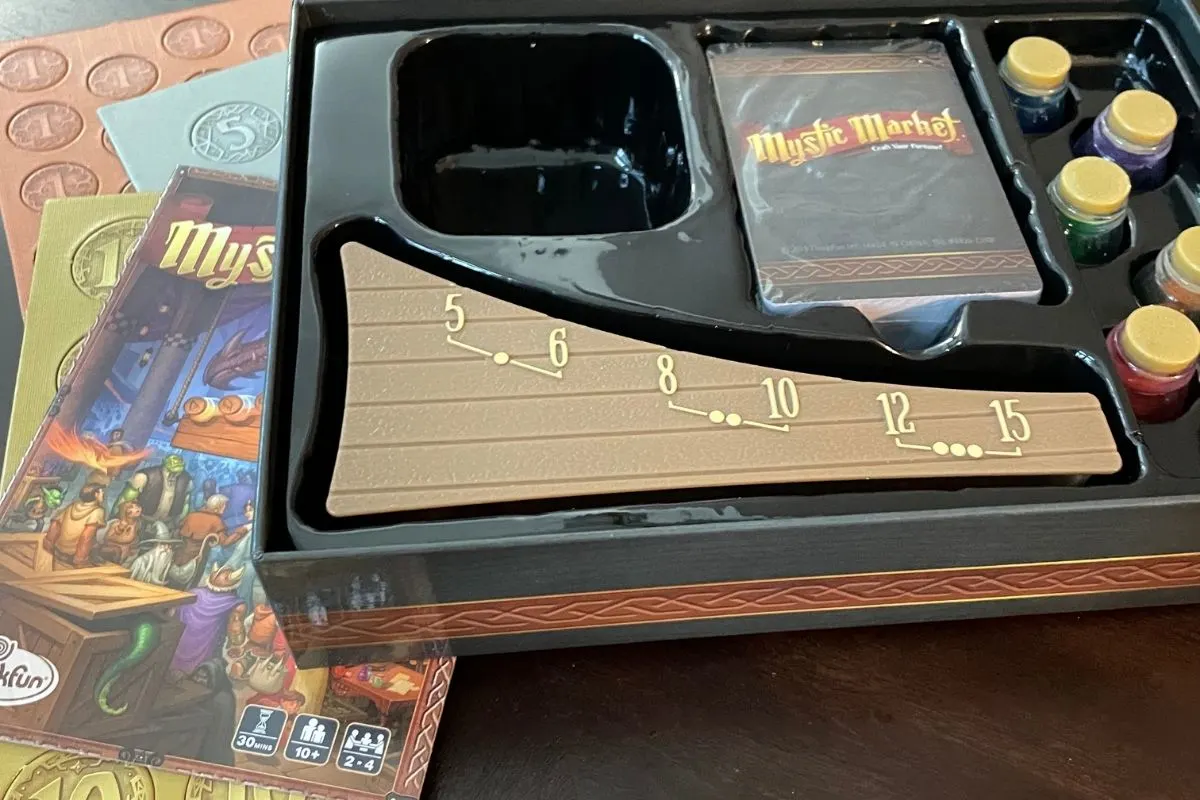
This is a part investing/part entrepreneur board game for kids, where the goal is to buy ingredients at a low price and sell a finished product (potions) at a high price.
What's neat about this game is how it forces kids to think about the cost of ingredients going into their end product, and how that can determine whether or not they make a profit or not.
Hugely important lesson!
And guess what? Just like the price of commodities changes in the real market, the price of the ingredients in this game changes throughout the play as well.
Each turn of play, the player can either:
- Buy ingredients
- Sell ingredients
- Swap ingredients
In addition to these three things, players can craft a potion if they have everything that they need to do so.
The winner is the player with the most points at the end of the game. Points are earned by both selling ingredients and by selling full product (potions).
Best Money Games for Kids #17: Lemonade Stand – Math Game
Suggested Age Range: 6+ years
Players: 2-4 players
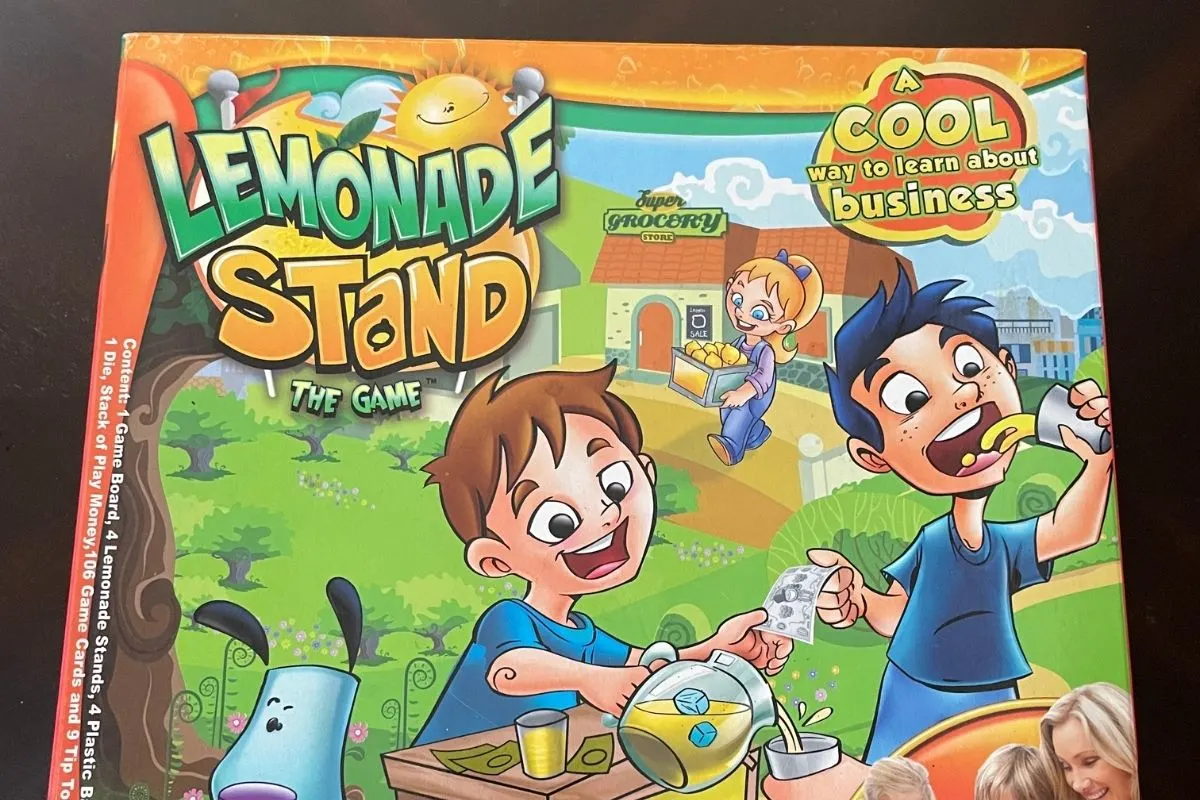
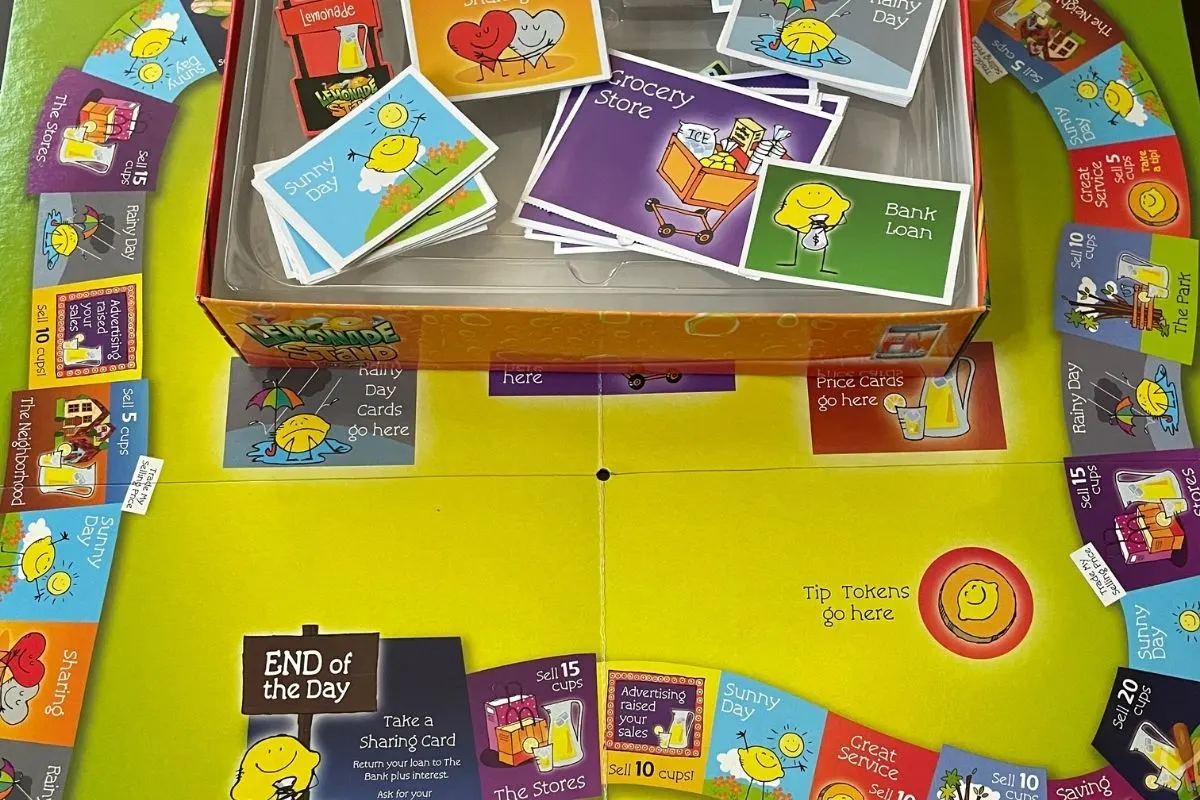
This game touches on some entrepreneurial/business money lessons, such as that you can’t just open up a lemonade stand and expect to make money.
There are capital costs to start a lemonade stand in this game, just like in real business. Each player starts out with a $20 loan from the bank, and must pay $2 for their lemonade stand!
The goal of the game is to finish with the most money, but this is after each player pays back their $20 loan + $5 in interest.
Cards drawn throughout the game include a Grocery Store Card (dictates the cost of your supplies), My Selling Price (dictates what you can sell the lemonade for), etc.
Location (such as “sports field” and “neighborhood” also gets chosen – how many cups of lemonade you can sell depends on where you’re located for that turn. Makes sense, right?
I think this would make an excellent supplement to a real-world lemonade stand you and your family set up. You can take the lessons learned in this game, and then apply them to your lemonade stand business plan to hopefully make more money!
Best Money Games for Kids #18: The Biz-Ops Game – Home Edition
Suggested Age Range: 9+ years
Players: 2-5 players
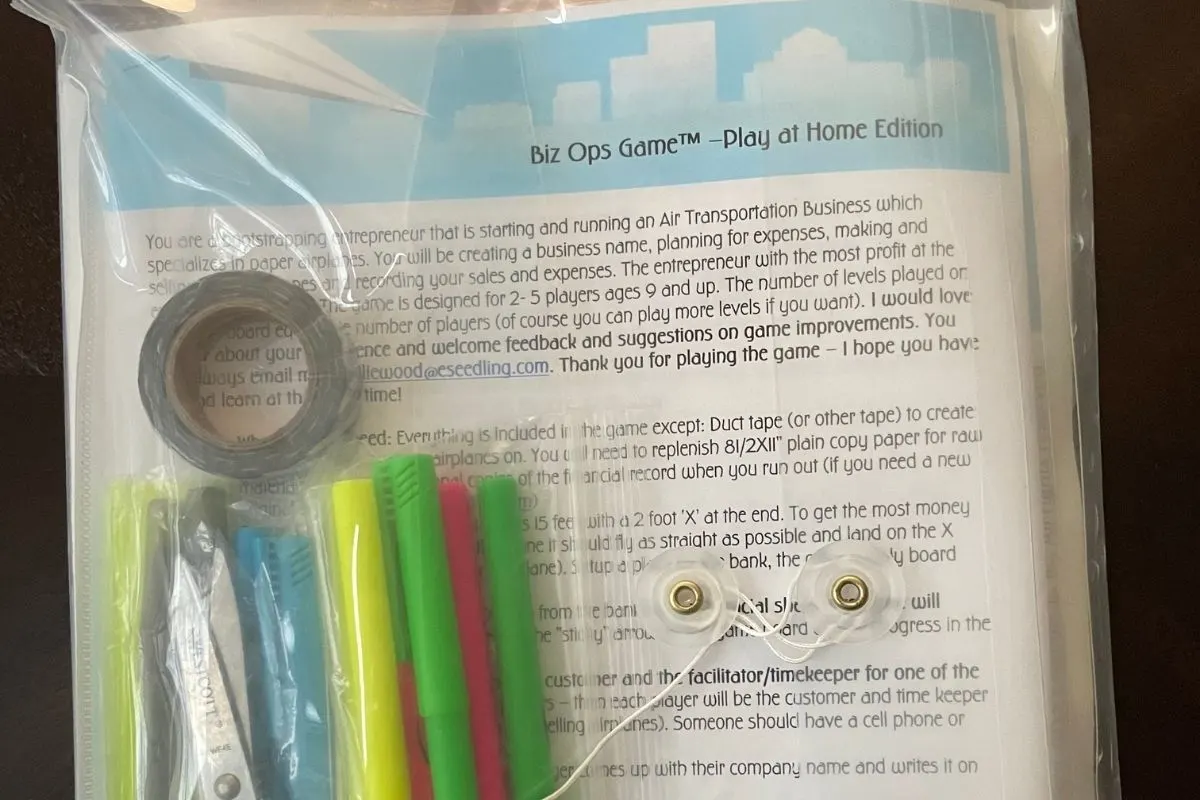
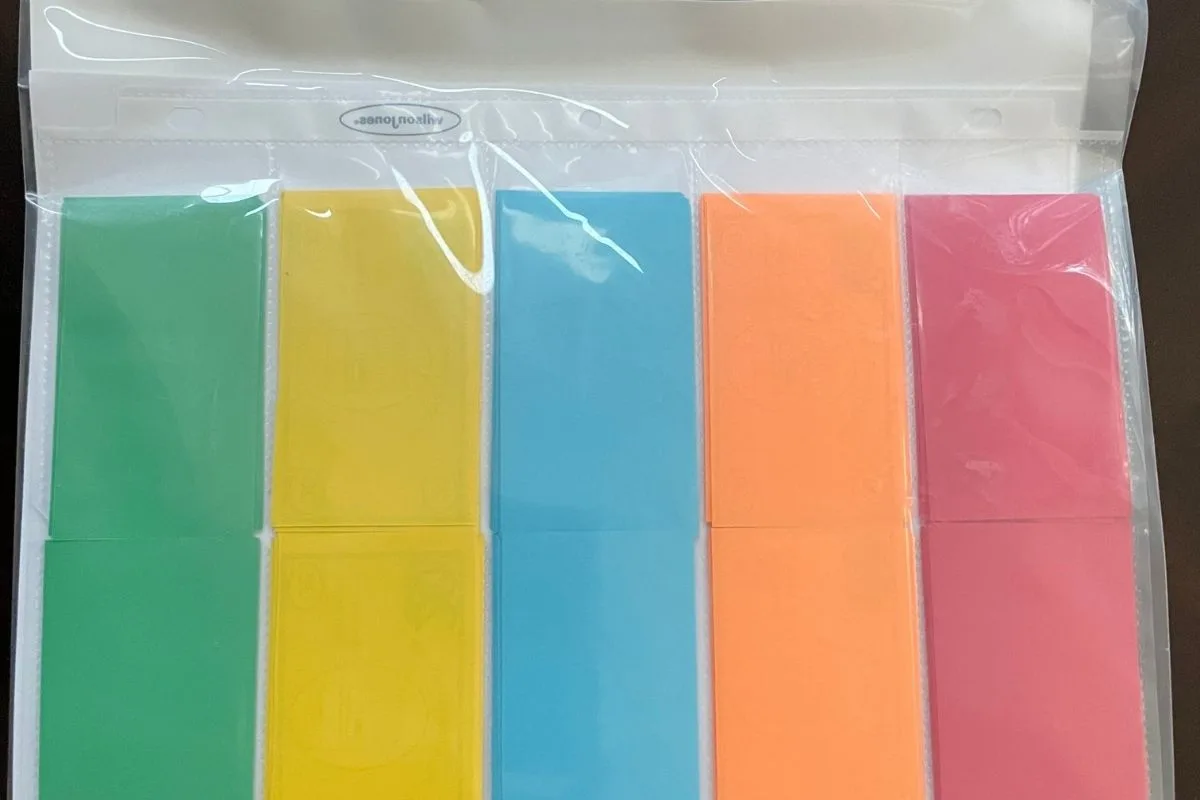
In this game, players are bootstrapping entrepreneurs who are attempting to bring the Air Transportation Business to life. Specializing in paper airplanes, the Air Transportation Business company needs to make a profit (as all businesses do!).
Players must create a business name, plan for expenses, make paper airplanes (their product), as well as sell them, and keep records of sales and expenses. Each player begins with a $200 bank loan and a financial sheet. Each person, like a true entrepreneur, is responsible for wearing lots of hats – buying raw materials, and office supplies, dealing with the bank, coming up with their company's name, designing and testing their product, selling their product to other players (who are the customers), etc.
And the customer – each player takes a turn as a customer – gets to choose how much they're willing to pay for the airplane depending on how well it's made.
For example: a customer is instructed to pay $500 for a paper airplane that flies straight and lands on the ‘X', but only $50 for a plane that flies all over the place (but is decorated by theme).
The entrepreneur who pays off their loan, has made a donation with some of their profits, and has made the most profit from anyone else is the winner.
I think this would be a lot of fun in a classroom environment!
Free Money Games for Kids
What child doesn't love to get mail? If you pair that with a FREE money video game…well now you're just asking for a high-pitch squeal.
Through its Practical Money Skills program, Visa is on a mission to educate the public about money management. The great news about this? They've created 4 money video games (free educational apps for kids) and they're giving them away to anyone (yes, including parents) who wants to have one.
You don't even have to pay shipping & handling!
I've tested out each of these games, so you can get a better sense of what they are below as well as the link for how to order one for your own kiddos.
Psst: also, here are 13 free printable money board games for kids and teens.
Free Money Video Game #1: Peter Pig's Money Counter
Age Range: 4-7 years
Money Lessons Learned: This game is mainly about learning to identify and count coins. Saving your money is encouraged instead of spending it by giving your child various-sized trophies depending on how miserly they become.
Earn virtual money with right answers that you can use to save or spend on decking out your pig with accessories and scenes. Plus there are lessons built into the game itself that occasionally pop up.
After your child earns some cash, they're asked how much they'd like to save. Then what's left is what they're allowed to spend at the store to deck out their little pig. I like how they show an image of the savings they set aside, as well as count down for the child how much money they have left to spend before it's all gone. Also, your child doesn't have to spend all their money either. What they don't spend gets put into savings.
Play it online for free here: Download immediately for your PC or Mac computer and begin playing now.
Free Money Video Game #2: Financial Football
Age Range: 11+ years (broken down into categories: Rookie 11-14, Pro is 14-18, Hall of Fame is 18+)
Money Lessons Learned: Key concepts include saving & spending, budgeting, as well as the wise use of credit.
Crafted in partnership with the NFL, expect some interesting play options in this game, such as a Sweep Left or a Quick Out. Your child even gets to select their team + their opposing team.
You choose a play − easy, medium, or hard − and you're given a financial question to answer. If you answer it correctly, then your football team gains yardage (the harder the question, the more yardage you gain when you get it correct).
What I like about this game is that if your child doesn't quite know how to answer, then can click the “Lessons” button on the Main Menu to enter the Financial Training Camp and learn all kinds of things, such as the difference between debit cards, credit cards, and prepaid cards.
Play it online now right here: Download immediately for your PC or Mac computer and begin playing now.
Which kid money games are you most excited to try?
Amanda L. Grossman
Latest posts by Amanda L. Grossman (see all)
- 50 Banking Activities for Kids (Student Financial Literacy) - February 14, 2024
- 14 Christmas Activities for High School Students (they’ll Actually Find Cool) - December 1, 2023
- 3 Fun Selfie Scavenger Hunts for Teens (Christmas, Fin Lit, etc.) - November 27, 2023

Q
Monday 1st of April 2019
Amanda,
This article provided some excellent game options to consider for my family, church group and to play with friends! Thank you for your thorough descriptions.
I look forward to reading more on your site! Q
Amanda L. Grossman
Monday 1st of April 2019
I'm so glad you like these money games for kids!